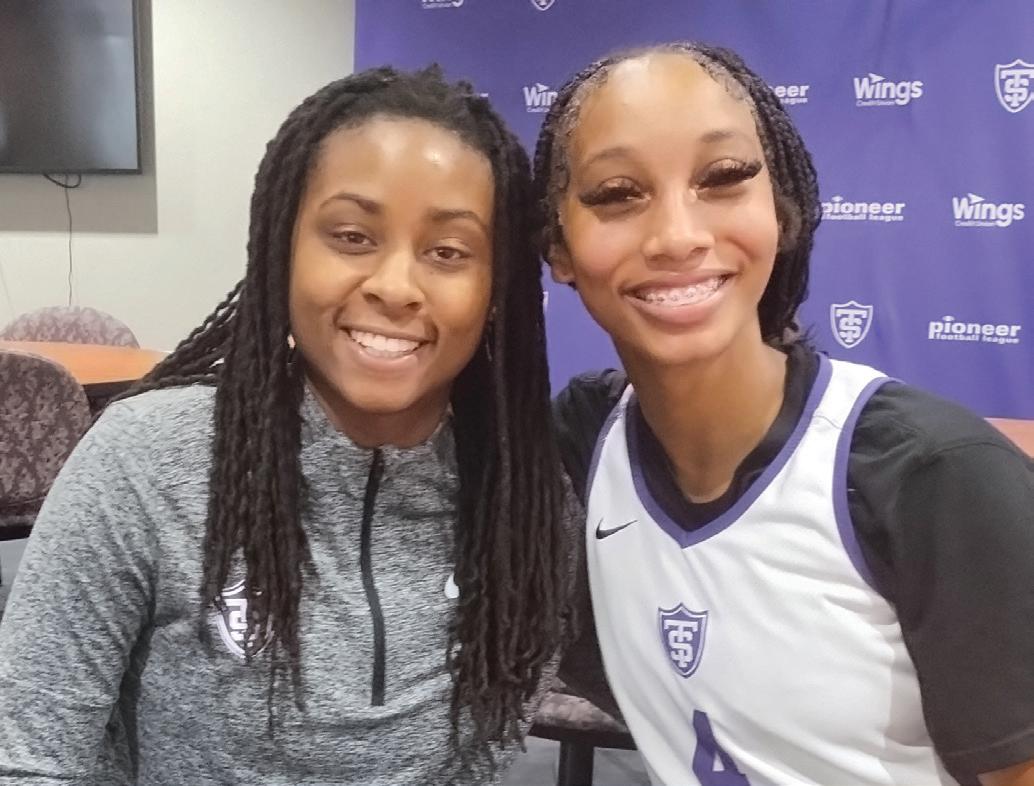




What might it mean then if more young Blacks go unchurched?
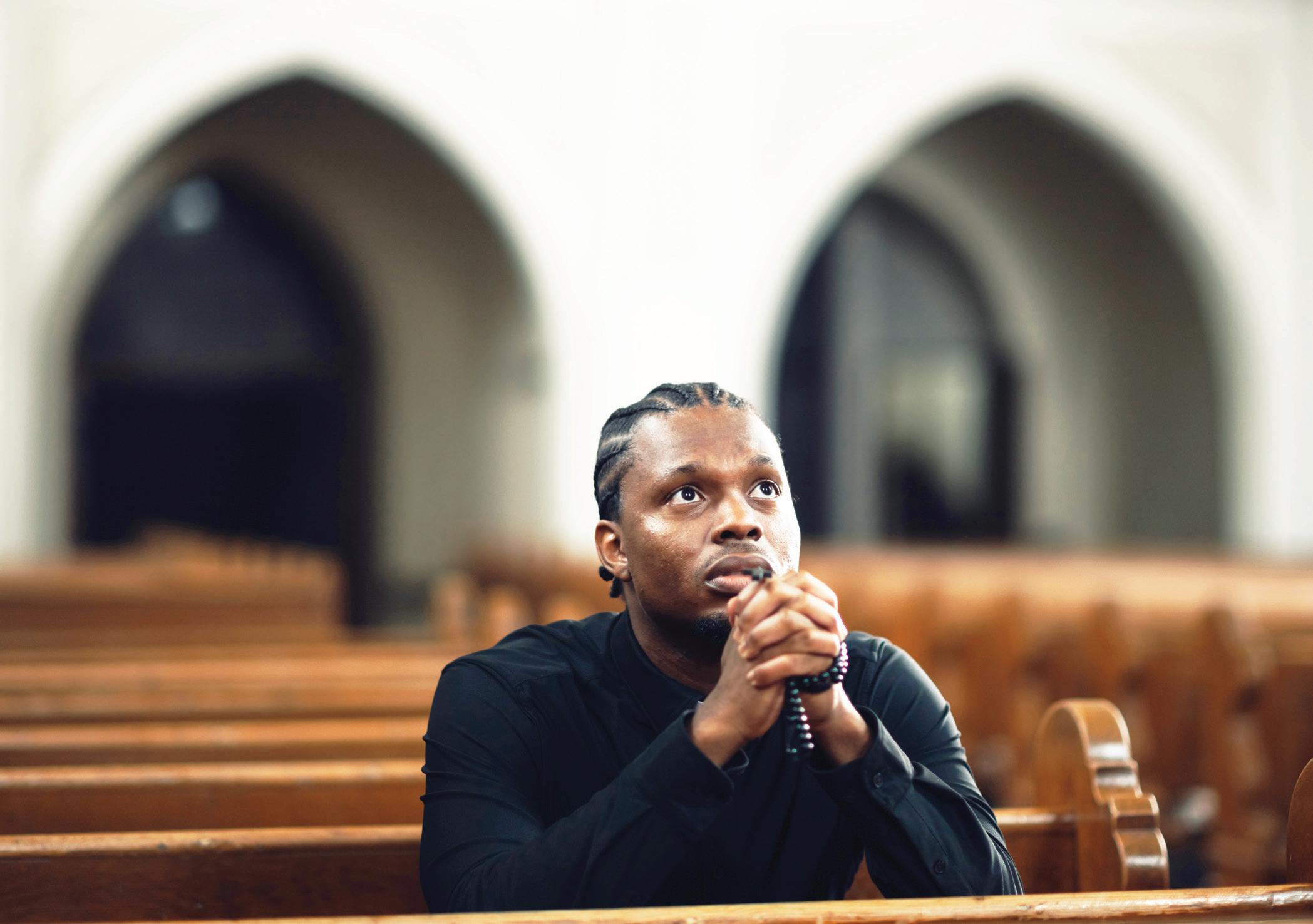
By Charles Hallman Staff Writer
re Black men still going to church? Research shows that nationwide fewer Black men, particularly young Black men, are attending services.
The Black Church has long been an institutional backbone in the community, with a foundational role in the Civil Rights Era— and providing a critical form of social cohesion and power, particularly political power.
So, what does it mean if this cultural institution declines in impact? Where do young Black men find the guidance, support, and political expression the Church historically provided?
Black Church-led campaigns to expand and protect voting date back to the Civil War, but momentum peaked during the Civil Rights Era of the 1950s and ’60s. In 1957, church and civil rights leaders organized the Prayer Pilgrimage of Freedom—a celebration on the third anniversary of the landmark Brown v. Board of Education decision that became a rallying cry for voting rights.
“To [the Rev. Martin Luther] King and other civil rights leaders, the Black Church was a key institution within the pro-democracy movement,” notes historian David Daniels III, who joined the faculty of McCormick
The Voting Rights Act of 1965 is one of history’s most profound civil rights achievements. Following its passage, the disparity in registration rates between Black and white voters dropped from nearly 30 percentage points in the early 1960s to 8 percentage points just a decade later.
Church initiatives and passage of the Voting Rights Act of 1965 had a powerful, positive influence on Black mobilization. Black voter turnout went from 40% in 1960 to 60% in 1984.
Historically, Black churches served as a source of comfort and support for Black men and a space where they could express their spirituality, connect with their cultural heritage, and seek support without fear of discrimination.
Theological Seminary in 1987 and was inaugurated professor of church history in 2003. “They believed its reach could be harnessed to eradicate the barriers to voting and expand accessibility of voting and enlarge the number of voters.”
The peak came in 2012, as President Barack Obama sought re-election. Black voter turnout that year reached 66.6% of eligible Black voters, which was 1 percentage point higher than overall white voter turnout. This threshold in Black voter mobilization has not been seen before or since.
According to two longtime pastors, local congregations are experiencing this trend in declining attendance numbers.
“Since the pandemic, I don’t see as many Black males coming to the church,” said Reverend Dr. Tracey Gibson, pastor of St Peter’s AME Church in South Minneapolis. She was first appointed in October 2022, two years after the pandemic forced churches to close and hold virtual services. “I wasn’t at the church before the pandemic,” she noted.
Shiloh Temple International Bishop Richard D. Howell, Jr. has been at the North Minneapolis church founded by his grandparents since 1980. “What I’m seeing, at least at Shiloh, is a significant slight increase of men coming, more men than ever before. [Yet] women still outnumber men.”
Howell added, however,
■ See CHURCH on page 5
By Alexzia Shobe Staff Writer
s a winter forecast to be colder and snowier than average fast approaches, tenants can rest easy knowing their right to a livable and comfortable environment is protected.
A law protecting tenants, Minnesota Statute 504b.161, dates to 1999, but it got a boost when Gov. Tim Walz signed into law a supplemental measure dealing specifically with heating at rental properties. It took effect on Oct. 1.
This statute originally required that landlords keep rental properties safe, wellmaintained, and energy-efficient—and reinforced tenants’ rights by prohibiting waivers or modifications that allowed landlords to shirk or shift responsibility of those requirements onto tenants.
This year’s supplemental act requires that landlords “supply or furnish heat at a minimum temperature of 68 degrees Fahrenheit” between Oct. 1 and April 30 for all units in
which landlords control the heat. Passage of the law came amid growing appeals from residents in need of help maintaining safe indoor wintertime temperatures. Minnesota residential utility customers have protection against utility service shut-off during the coldest months of the year. The Cold Weather Rule prevents utilities from shutting off heat sources between Oct. 1 and April 30 based on lack of bill payment. The new law extends the same protections to renters without control over heat levels in their apartments.
Samuel Spaid, staff attorney and research director at HOME Line, was at the forefront of discussions over the new rule. “This was a change to the law that HOME Line really championed at the state legislature,” he said, “because we receive hundreds of calls each year about the lack of heat or inadequate heating, which can have serious health consequences—especially for children and seniors.
■ See COLD on page 5
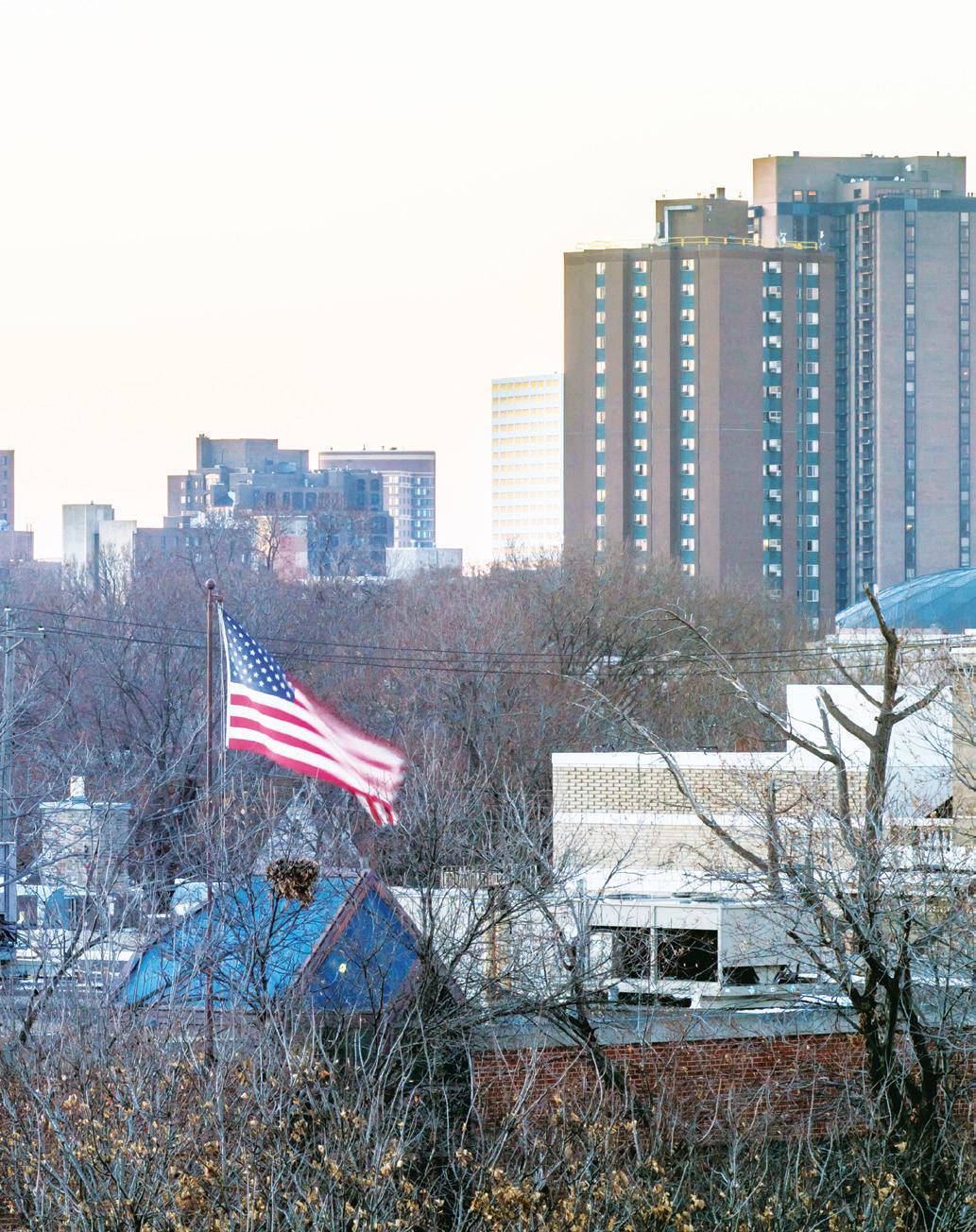
Before the statewide standard went into effect, wintertime heat protections varied—with some cities and towns not offering tenant protections.

By Stacy M. Brown
ccording to the latest Consumer Price Index (CPI) report from the Bureau of Labor Statistics, inflation in the United States has slowed to its lowest level since the early months of the pandemic. The CPI for All Urban Consumers rose by 2.4% over the past year, a substantial easing from the higher inflation rates seen over the last two years. September’s monthly increase of 0.2% matches the growth recorded in August and July, indicating a steady, moderate rise in consumer prices.
The most significant contributors to the monthly increase in CPI, a vital indicator of inflation that measures the
price change for goods and services affecting consumers’ daily lives, were shelter and food, which comprised over 75% of the overall rise.
Food prices alone increased by 0.4% in September, with the cost of meats, poultry, fish and eggs rising sharply by 8.4%. Fruits and vegetables also saw a notable increase of 0.9%. These rises reflect ongoing pressures on household budgets as essential goods continue to grow more expensive.
A cooling of inflation bodes well for Black Americans. Research in 2022 revealed that, at a time when households across the U.S. widely reported experiencing serious problems from inflation, Black Americans were disproportionately affected by rising costs.
According to a poll conducted by NPR, the Robert Wood Johnson Foundation, and the Harvard T.H. Chan School of Public Health, 55% of Black Americans report facing serious financial difficulties, compared to 38% of white Americans.
The survey also showed that Black Americans are more likely to lack emergency savings, with 58% unable to cover even a month of expenses, compared to 36% of white respondents. Food insecurity also presented a more pressing issue, as 32% of Black Americans report struggling to afford food, compared to 21% of white Americans.
The nonprofit Prosperity Now said the index showed housing prices increased by 0.2%, remaining a major
stumbling block for American families seeking security and economic stability. The organization noted that housing costs remain a significant hurdle for families striving to build wealth and achieve longterm financial security through homeownership.
“Homeownership has long been one of the most reliable ways to build wealth in this country, but for far too many families it remains out of reach,” said Marisa Calderon, president and CEO of Prosperity Now. “While it’s encouraging to see inflation slow, we must ensure that economic gains translate into real opportunities for families to build a more secure financial future.” The
By Vickie Evans-Nash Contributing Writer
Meet Minneapolis’ Melvin Tennant says it’s a good time to market the city of Minneapolis. As the organization’s president and CEO, he is “living the dream,” he says, ending a record-breaking summer that helped the city rebound from the effects of an economic decline.
“We suffered more than virtually any other city in the country at the start of the pandemic,” he says of the loss of leisure and business travel revenue. “We are the home of so many Fortune 500 companies where many of their vendors and employees come here on a frequent basis.” During the pandemic, he says, “that came to a screeching halt.”
Meet Minneapolis works with local travel and hospitality partners to recruit major specialty events. Their crown jewel this summer was the U.S. Olympic gymnastics trials in late June at Target Center, a big boost toward recovery.
The two main reasons visitors come to Minneapolis are to attend special events and to spend time with friends and family. As a regional destination for visitors in Greater Minnesota and bordering states, Minneapolis tourists can choose from a variety of restaurants, as well as attend
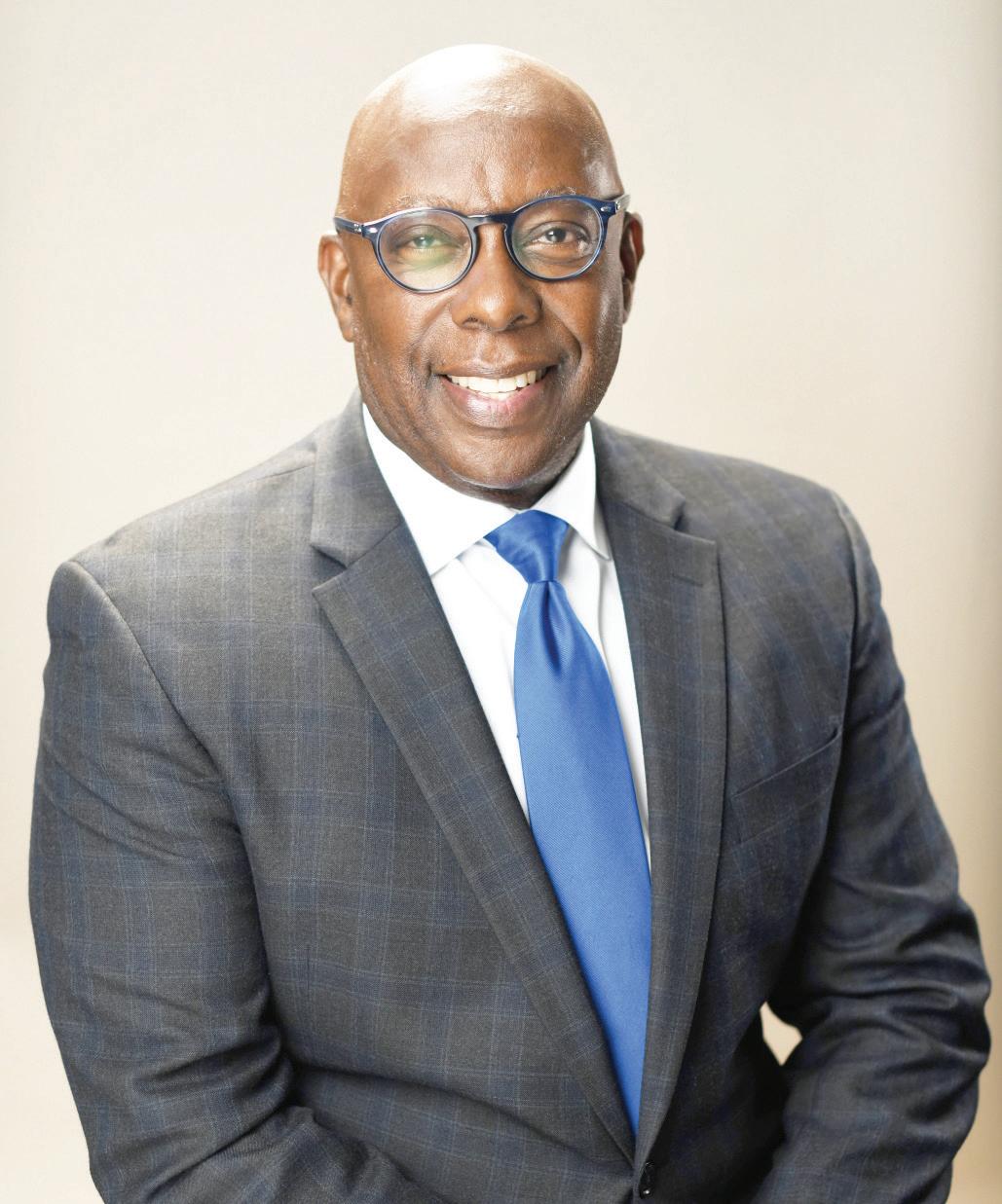
live theater, concerts, and professional and collegiate sporting events.
The city is also a draw because of our lakes, rivers, and park systems. “We’re just very blessed with having all of those assets,” says Tennant.
Though he doesn’t yet foresee another event that compares to the Olympic trials in magnitude, several events are coming to the city in the next year. This includes the Women’s NCAA Ice Hockey championship, hosted next year by
the U of M’s Ridder Arena. The 2025 Boys Junior National Championship, held at the Minneapolis Convention Center, is expected to draw about 25,000 athletes, families and fans in early July.
“We can’t live just on major high-profile events,” explains Tennant. “We have to have events that are coming on a regular [and] consistent basis.”
The 2025 events calendar also includes the Heart Failure Society of America (HFSA) annual scientific meeting in Sep-
When our rights are on the line we fight and when they’re on the ballot we vote, because we’re not going back.
The economy is on the ballot. Health care is on the ballot. Criminal justice reform is on the ballot. Reproductive freedom is on the ballot. Environmental justice is on the ballot. The right to vote is on the ballot.
If we do our part and show up to the polls, we will make history (again)!
Let’s vote for progress and the future we deserve. Vote for the leader who’s been fighting for us for years.
Election Day is November 5th. Vote for Kamala Harris.
tember. The American Indian Science and Engineering Society national conference will be held in October. “I would call those kind of meat-andpotato events,” says Tennant.
Approaching 18 years as director of Meet Minneapolis, Tennant says, “What has sustained me is just the spirit of development and the can-do attitude of the leadership of the city.” During his tenure, expanded infrastructure included U of M’s Huntington Stadium in 2009, the Twins Stadium in 2010, construction of the US Bank stadium in 2016, and the renovation of Target Center in 2019.
“We’ve done all these things that have allowed us to recruit events that we would not be able to host before,” says Tennant. Yet it’s not just the brickand-mortar infrastructure that makes his job interesting.
“It is the underlying relationships and the commitment of the community to get things done,” Tennant says. “That’s been the most fun aspect of my career since I’ve been here.”
Recently he was looking at a picture of downtown Minneapolis that captured the Nicollet Mall in the early 1970s. Its boulevard was lined with shops and major department stores— many of them now gone.
Like most downtown areas across the country, Minneapolis experienced the phe-
nomenon of major retail stores migrating to suburban malls.
What others may see as a barrier to growth and expansion, Tennant sees an opportunity to reimagine what Minneapolis’ downtown looks like and has to offer.
The reimagined building housing the historic Dayton’s department store will once again offer a holiday market with more than 100 vendors. This vision also includes con-
that reality.”
With the support of the Minneapolis Downtown Council, these efforts are geared toward increasing opportunities for businesses and entrepreneurs of color. Chameleon Shoppes offers downtown space for vendors at an affordable price. Benjamin Johnson, the city’s arts and culture affairs director, supports artists of color by displaying their work in downtown storefronts.
“As we reimagine downtown, we don’t want to come back the way we were, where there were barriers to entry for many communities.”
verting what was once office space into residential units.
The reimagined Holidazzle also will return this winter.
“We understand that it’s going to have to take a different approach to create the really vibrant downtown that we did [have] once before,” says Tennant. “But we are working with a lot of our partners to make
“As we reimagine, we don’t want to come back the way we were, where there were barriers to entry for many communities,” says Tennant. “There is a strong effort to try to rectify that.”
Vickie Evans-Nash welcomes reader responses to vnash@ spokesman-recorder.com.
Saint Paul NAACP Election Saint Paul NAACP Election of Officers Saturday, November 23rd 11 a.m. - 3 p.m. Election conducted by email or text ballots from “Election Buddy” to all members. For further info: (651) 649-0520 Minnesota Spokesman-Recorder October 24, 2024
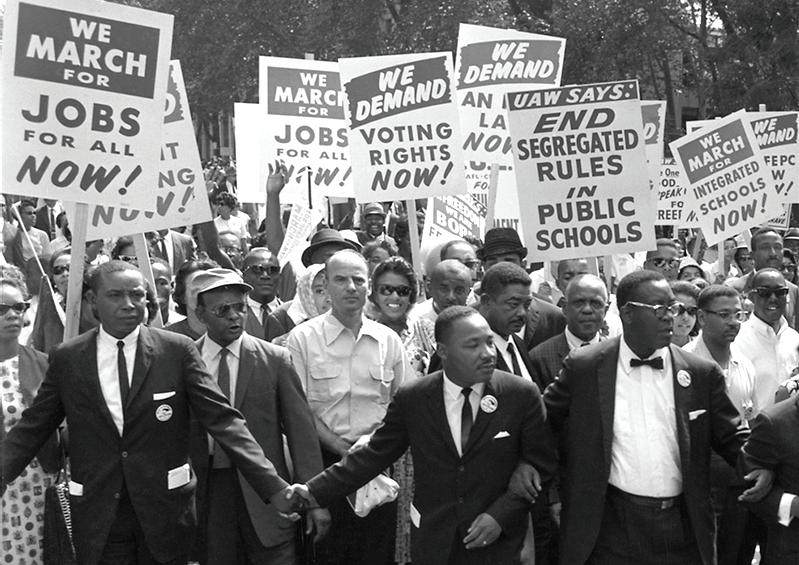
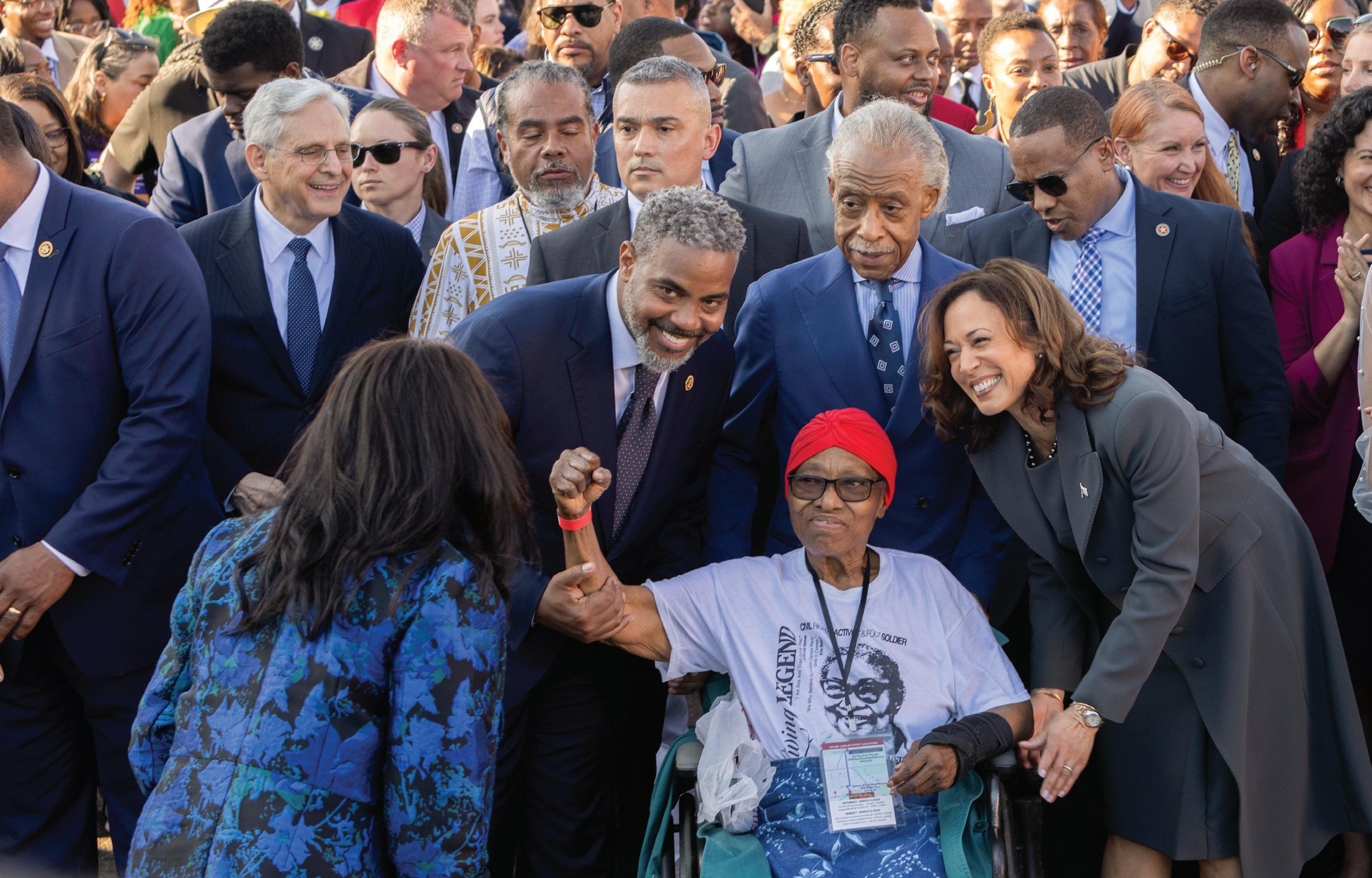

By Albert — UCare plan de-complicator
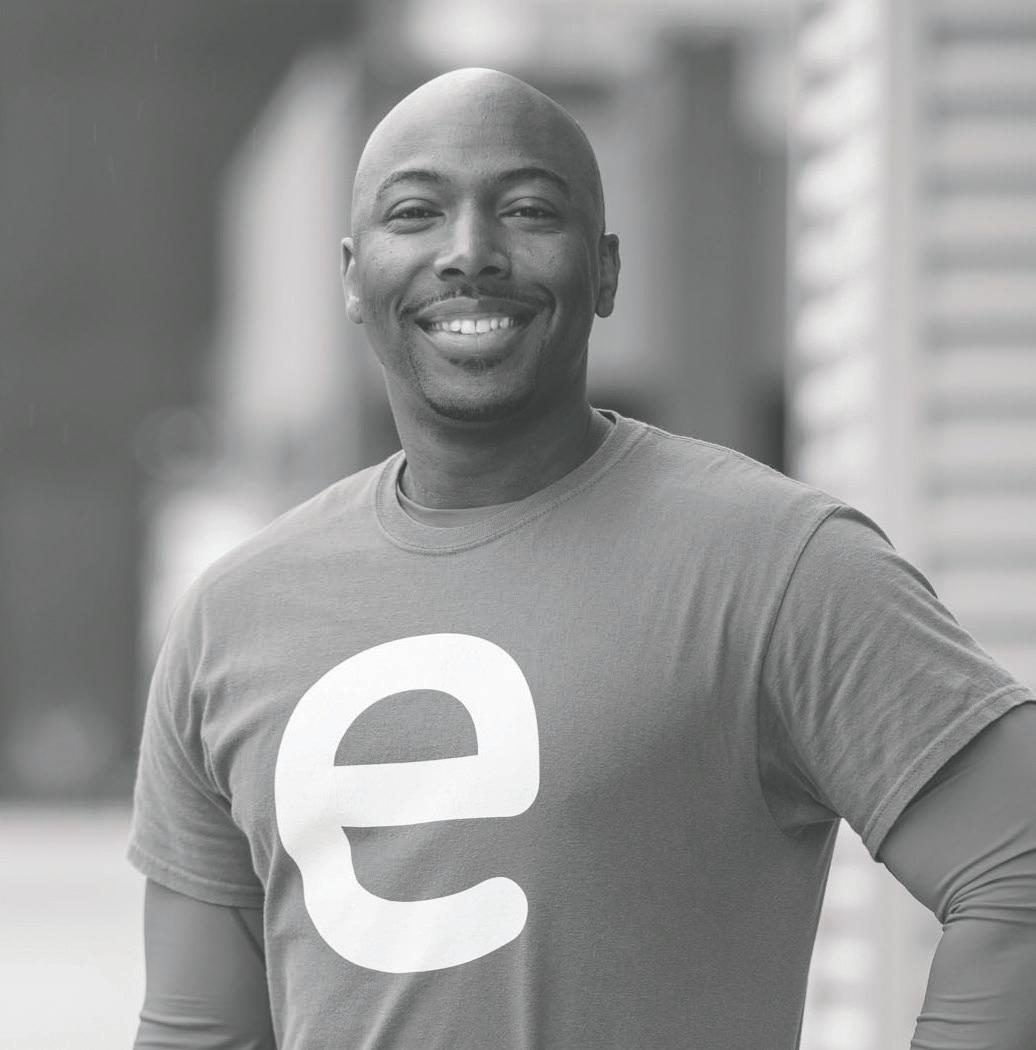
When you reach Medicare age, it can be a little overwhelming. It’s like a whole new puzzle of health plan coverage that needs to be solved. There are many who call me and ask, “Can you just put it together for me?”
At UCare, we can certainly do that. But we also really want members to understand what they are getting and why. The plan you select all depends on your life and what kind of coverage you need and don’t need.
Apart from Original Medicare, there are two plan types that people who are aging into Medicare gravitate toward: Medicare Advantage plans and Medicare Supplement plans. Let’s dive in.
Think of a Medicare Advantage plan like a bundle of benefits. It combines your Original Medicare, Part A (hospital insurance) with Part B (medical insurance). UCare Medicare Advantage plans give you extra coverage and benefits like dental, prescription eyewear and hearing aids. Most plans also include prescription drug coverage (Part D), which can become increasingly important as you age.
UCare has been offering Medicare Advantage plans since 1998 — longer than any
other health plan provider in Minnesota. And today, they’re some of the most popular plans. We have a range of Medicare Advantage plans to choose from that include coverage while you travel and allowances for over-the-counter purchases.
One more thing: UCare Medicare Advantage plans work fantastically for local Minnesotans, due to their large network that includes 97% of Minnesota medical clinics and hospitals.* So if you have a clinic you’ve always used, your chances are good that it’s in-network. And with no referral needed to see a specialist, getting the care you need is easy.
A Medicare Supplement plan is something you pair with your Original Medicare. In other words, it supplements your plan. Get it? These policies help pay for the out-ofpocket costs that are not covered by Original Medicare (Part A and Part B).
The main benefits of a UCare Medicare Supplement plan is protection and predictability. You will have low or no copays or coinsurance when you get care, so your costs are predictable. Your monthly premiums are your main costs — no more unexpected medical bills. Speaking of, UCare’s Medicare Supple -
ment plans offer some of the lowest Medicare Supplement premiums in Minnesota.
Another great benefit of a Medicare Supplement plan is the nationwide coverage. You can see any doctor who accepts Medicare patients, anywhere you go in all 50 states. This is especially useful whether you’re traveling, moving or living in a place where there are fewer providers nearby.
You also get extras like no-cost fitness memberships and discounts on hearing aids.
Why roll with UCare?
I’ve just gone over a couple categories of plans, but please know that we have a variety of plans for everyone, all across Minnesota! Each of them is designed to meet your health and lifestyle needs. The best way to know which one is right for you is to sit down with a broker, or someone like myself, to help find the plan that’s right for you.
Finally, I’ve been riding with UCare for nearly 10 years now, and I can honestly tell you — it’s the people who make our company go. That’s why we often say we’re “people powered” — never stopping until we know that you understand your plan and you’re comfortable with it. And if there’s ever a problem, we don’t send you up a phone tree. We work the problem individually until it’s solved. It might be why nearly 95% of UCare Medicare Advantage members choose to stay with UCare year after year.**
If you have any questions about anything I’ve covered, you should reach out to your local broker. They can help you decide which plan makes the most sense. Visit ucare.org/ma to find a broker near you.
You can also give UCare a call at 1-866-460-5093 or stop by the headquarters in NE Minneapolis or our Duluth office.
UCare headquarters
500 Stinson Blvd NE Minneapolis, MN 55414
Monday – Friday, 9 am – 4 pm
UCare Duluth office
325 West Central Entrance Suite 200 Duluth, MN 55811
Monday – Friday, 9 am – 4 pm
Based on 2023 CMS data
**Based on internal UCare enrollment data from 2022 compared to 2021
By Jennifer Porter Gore
A little less than a decade ago, it was alarming news that shook the nation. Deaths from suicide, drug overdose, and alcohol-related liver disease were slashing the life expectancy among white Americans.
The “deaths of despair” phenomenon centered mostly on non-college-educated whites whose declining socioeconomic conditions, researchers said, led to a spike in premature deaths between 1999 and 2013.
But researchers at the University of California-Los Angeles medical school and other institutions have found that deaths of despair have skyrocketed during the last seven years. The spike, researchers say, has been fueled by the exploding use of illegal drugs such as fentanyl and heroin, as well as an increase in alcohol-related deaths around the same time as the Covid-19 pandemic began.
In fact, “From 2015 to 2022, the mortality rate from deaths of despair nearly tripled among Black people, and it also has surpassed the rate among white people,” says the analysis, published in “JAMA Psychiatry.” The rates among American Indian or Alaska Native midlife adults in 2022 also were nearly 2.4 times higher than for whites.
“While the opioid crisis did raise drug overdose deaths among white Americans for a time, it was an anomaly,” says
Joseph Friedman, the social medicine expert at UCLA who was the lead author on the analysis. But by 2022, he says, the rate of such deaths among whites had started to decline but had increased exponentially among Black people.
“What’s really important is that now, with these three causes of death, the gap has closed, and it’s moving in the other direction,” Friedman said.
The deaths of despair theory reached the national agenda in 2015 when two Princeton University economists argued that poor mental health, stemming from a lack of economic opportunities, was behind rising premature mortality rates among less-educated whites.
The UCLA researchers added that flaws in the methodology of the 2015 report didn’t give enough consideration to longstanding racial inequities in income, educational attainment, incarceration, and access to quality medical care. Those factors, they wrote, can contribute to drug use and poor mental health outcomes.
Because they did not consider those flaws, the Princeton study distorted conclusions about who was most at risk of death of despair, according to the UCLA research.
Statistics for Native Americans weren’t included at all, which UCLA first pointed out in a January 2023 report.
“It was burned into the American psyche that it was white people in the rural U.S.” who were most at risk of dying
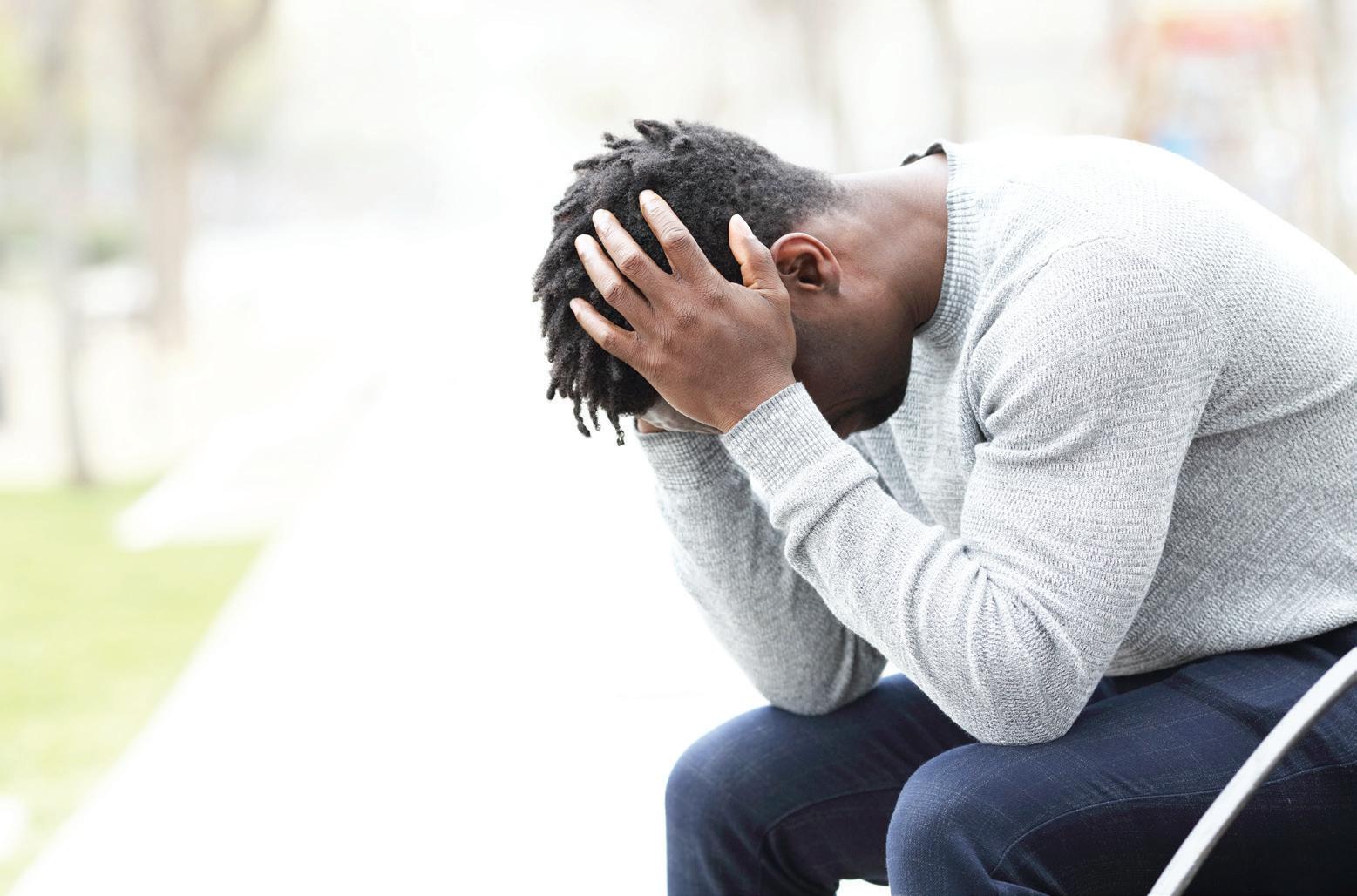
Despite the fact that racism is recognized as a public health crisis, access to medical care for Black people— including mental health care— remains a significant challenge.
prematurely, Friedman said. “It was just a very small piece of the truth that was very interesting but was widely sold as something it wasn’t.”
Without question, America’s mental health crisis writ large has gained more attention in the past two decades, and it became Topic A during the Covid-19 pandemic. Yet multiple studies show overall well-being is still under-addressed and under-treated— especially among Black Americans, who continue to face barriers to adequate mental health care.
According to Centers for Disease Control and Prevention data, one in five adults in the U.S. live with a mental illness, including just more than
21% of Black people. Suicide is now the second-leading cause of death among young people ages 10 to 14, and the suicide rate among Black youth ages 10 to 19 surpassed that of white peers for the first time in 2022.
The rate has increased 54% since 2018, compared to a 17% decrease for white youth. But almost 20% of all youth ages 6 to 17 experience a mental health disorder each year, ranging from anxiety and depression to more severe illnesses like schizophrenia and bipolar disorder.
Despite the fact that racism is recognized as a public health crisis, access to medical care for Black people—including mental health care—remains
a significant challenge. More than half of all adults with mental illness do not receive treatment, according to the Substance Abuse and Mental Health Services Administration.
An analysis from KFF, a health policy research firm, found that Black (39%) and Latino (36%) adults who report fair or poor mental health are less likely than white adults (50%) to say they received mental health services in the past three years. Barriers to access included “costs and difficulties finding providers, with people of color citing additional challenges such as difficulty finding providers with shared background and experiences, lack of information, and stig-
ma and embarrassment,” according to the KFF analysis.
Having culturally competent care—clinicians intimately familiar with the lived experiences of historically disadvantaged groups—is essential for effective mental health treatment. Yet according to the KFF survey, 41% of Black respondents said it was either “somewhat” or “very difficult” to find a mental health care provider who understood their issues, could schedule an appointment in a timely manner, and who were affordable.
At the same time, just 4% of psychologists and 2% of psychiatrists are Black, according to their respective medical professional organizations. Experts say that further exacerbates the challenge of finding culturally competent care.
Jennifer Porter Gore is a writer living in the Washington, DC, area.
IF YOU NEED EMOTIONAL SUPPORT, ARE THINKING ABOUT SUICIDE, OR ARE WORRIED ABOUT SOMEONE ELSE, call or text the National Suicide & Crisis Lifeline at 988.
Help is available 24/7. TTY users can dial 711 then 988 to get help.
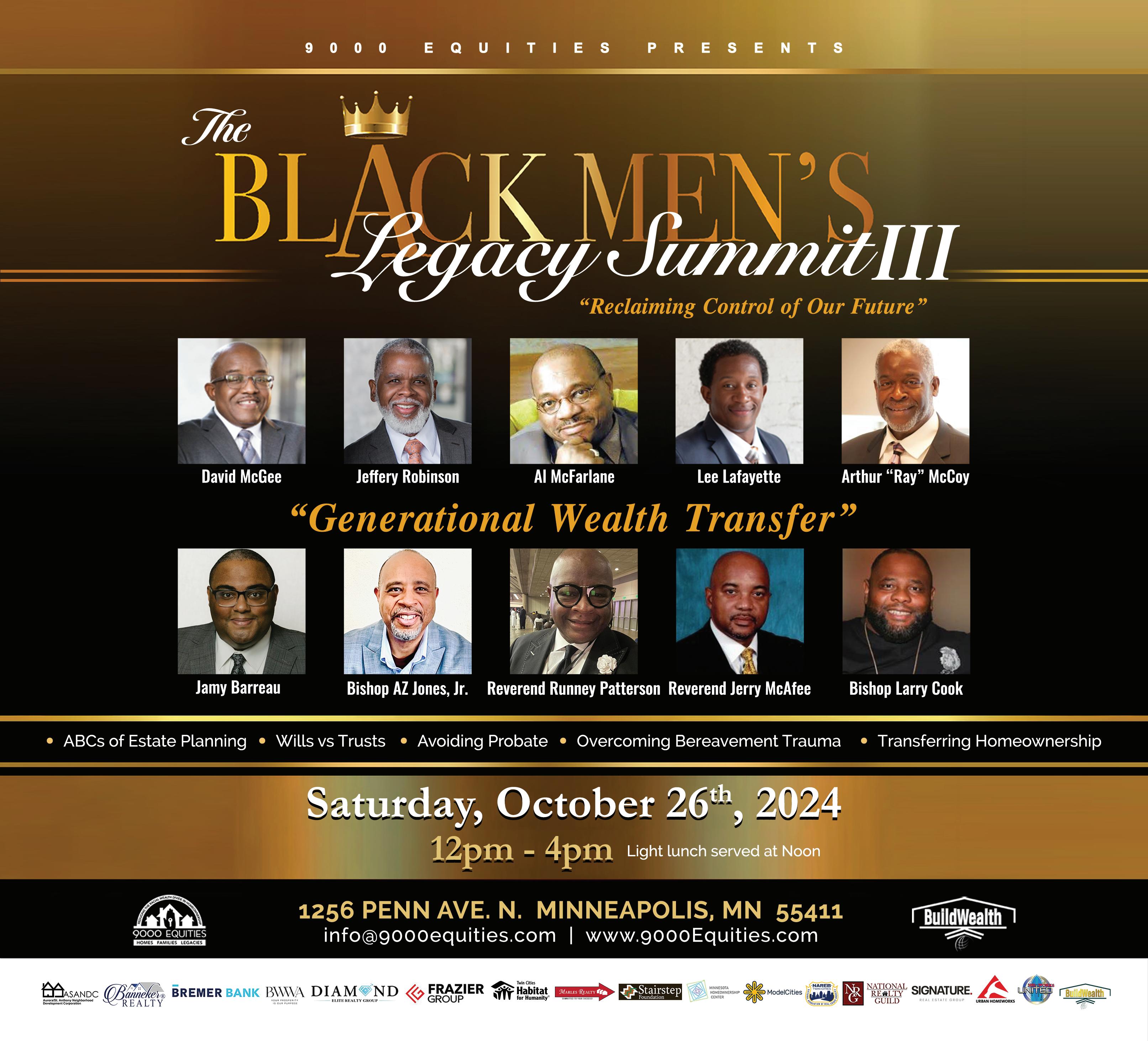
Continued from page 1
“We’ve seen a decline of Black women in Protestant churches overall across America. Since the pandemic, we’ve seen a tremendous decline.”
Historically, Black churches served as a source of comfort and support for Black men and a space where they could express their spirituality, connect with their cultural heritage, and seek support without fear of discrimination.
Bishop Howell noted, however, that regular attendance in Black churches began to decline decades ago. “After Dr. King’s assassination in 1968, we started having new generations who never went to church. They stopped going,” he explained.
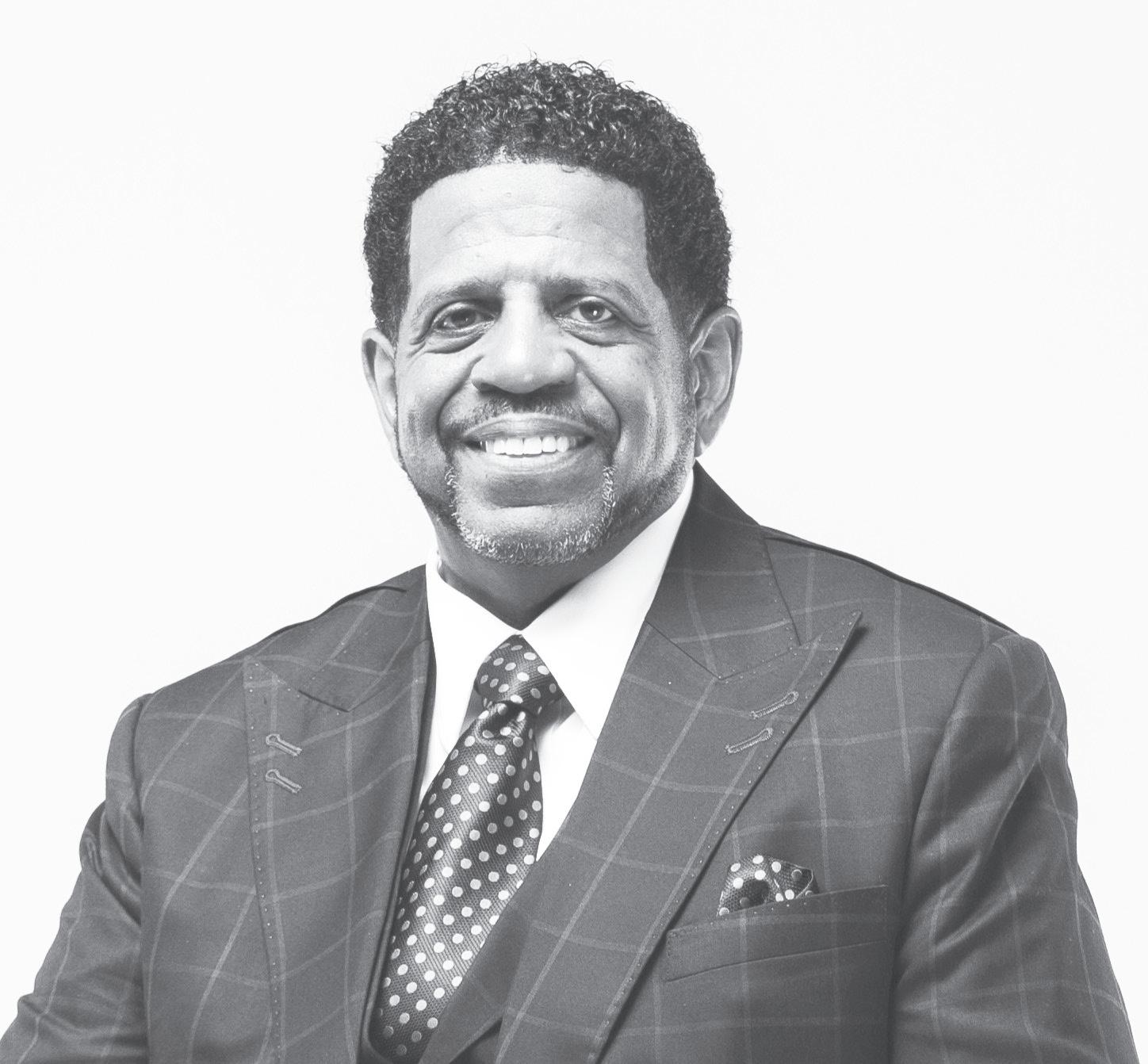
Two-thirds of older Blacks— Baby Boomers and Silent Generation—say they regularly attend Black churches, slightly more than half of Black Generation Zers and Millennials. A more recent Pew study found 47% of Blacks attend church at
agree that Black attendance in church is not like it used to be, especially among Black men.
“I think some of it is generational, because the older men, 50-plus, 60-plus, they do come,” noted Gibson. “A couple of younger guys come
lately “a rise of men within their 40s and up. Some are starting to come to church and asking questions because they are mostly wrestling with their destiny.”
The bishop pointed out that Black churches may need to devise better outreach strategies. “The church has to do a better job…in really having conversations with these new, unchurched individuals.
“That does mean going to homes, going to prisons, going to hospitals, going to the street, creating conversational groups within the building itself, or where the church is meeting, and inviting these individuals to come and have a conversation.
Continued from page 1
“The new rule sets a clear standard, giving tenants the ability to enforce their right to adequate heating by taking their landlord to court if necessary.”
Before the statewide standard went into effect, wintertime heat protections varied— with some cities and towns not offering tenant protections against predatory or otherwise nonresponsive landlords. Abbie Hanson, housing justice litigator with the Housing Justice Center, often aided families affected by such a lack of protections.
“People’s homes, which they pay substantial rent for in exchange for a functional living environment, would have inadequate, or even non-functioning, heat,” Hanson said.
“This resulted in situations varying from children having to wear three pairs of socks because it was uncomfortably cold, to dangerous scenarios wherein furnaces went out in mid-January and families were
Many Pew Research Center studies in recent years have found that Black Americans tend to be more religious than white Americans.
A 2021 Pew report, which at the time was its largest sample, surveyed 8,660 Black
“So now…in the Black populations, we probably have more unchurched than we do in church. There is absolutely no familiarity with the church at all [among these individuals] outside of funerals.”
forced to resort to utilizing their ovens as a source of heat.”
This is especially hard on low- and moderate-income individuals and families, who struggle even more when forced to pay additional money toward other utilities to maintain a safe living environment once temperatures drop.
Advocates like Hanson and Spaid note the obvious benefit to tenants, but landlords—particularly those with properties in different locales—also are
“People’s
adults between November 19, 2019, and June 3, 2020—almost double the 4,574 nonBlack adults surveyed for comparison. It found that 60% of Black Americans attend services in Black congregations, and 7 in 10 Black adults say that the church offers them spiritual comfort.
heat to speak up now. “Always begin with attempting to have a conversation with the landlord,” he said. If that fails, however, help is available.”
Where to find help
If you are a renter with a landlord in violation of these new standards, there’s help.
A Rent Escrow Action (REA) is a legal process that allows tenants to request court intervention to compel landlords to make necessary repairs or
homes, which they pay substantial rent for in exchange for a functional living environment, would have inadequate, or even non-functioning, heat.”
aided by the new law. Previously subjected to a patchwork of ordinances, landlords now are responsible for meeting standards outlined in a single, statewide law.
With the law now fully in effect, Hanson encourages residents without appropriate
1.9% over the past month. Gasoline prices dropped by 4.1%, continuing their downward trend and offering some relief to consumers. Over the past 12 months, the energy index has decreased by 6.8%, primarily due to a significant 15.3% drop in gasoline prices and a steep 22.4% decline in fuel oil costs. Meanwhile, electricity and natural gas costs have seen smaller increases of 3.7% and 2.0%, respectively.
Excluding the more volatile food and energy sectors, the CPI rose by 0.3% in September. This broader measure of inflation, which includes categories such as health care, motor vehicle insurance and apparel, reflects more sustained price increases across various goods and services. Medical care costs, which had previously declined, increased by 0.4% this month, while motor vehicle insurance and airline fares both saw notable jumps, rising by 1.2% and 3.2%, respectively. Shelter costs have increased
uphold lease terms. It requires tenants to provide written notice of needed repairs to their landlord 15 days before filing.
An REA can lead to reduced rent or mandated repairs, all while protecting tenants from eviction for asserting their rights. Visit www.MNCourts.
over the past year by 4.9%, forming a significant part of the overall inflation picture. Motor vehicle insurance costs have
“We
surged by 16.3% annually, reflecting heightened expenses in this sector. In contrast, other
“I think some of it is generational, because the older men, 50-plus, 60-plus, they do come. A couple of younger guys come because they’re on a ministry that they’re responsible for. There are not many [Black] men.”
least once a week—more than Latinos (39%), Whites (34%), and other/mixed respondents (34%).
Both Gibson and Howell
gov/SelfHelp or call the Statewide Self-Help Center at 651435-6535.
An Emergency Tenant Remedies Action (ETRA) is similar but, as the name indicates, is for emergency situations. If a resident’s home is dangerously cold, it is recommended that they give their landlord 24 hours’ notice before filing an ETRA. That will put them on the fast track for receiving a hearing before a judge. There is a filing fee, but tenants can apply for a fee waiver if needed.
Follow these steps to fill out an ETRA:
• Go to lawhelpmn.org and fill out the form. You can also get a form from the court.
• You must try to tell the landlord 24 hours before you file. Make sure you document all the ways you try to tell your landlord (like texts, calls, emails or in person).
• If you can’t reach the landlord, leave a message giving 24-hour notice.
• In your 24-hour notice, tell your landlord what your housing emergency is and that you need it fixed within 24 hours or
categories, such as recreation and communication, saw slight decreases of 0.4% and 0.6% this month, respectively.
because they’re on a ministry that they’re responsible for. There are not many [Black] men,” said the pastor. Howell said he has seen
you will file an ETRA. You have to tell your landlord that you will file in court to ask for emergency relief if they do not fix the problem.
• If the landlord does not fix the emergency within 24 hours of your notice, you can file the ETRA.
• If you try to reach your landlord to give the 24-hour notice but can’t do so, go ahead and file.
If you have a low income, you can fill out a court fee waiver form to ask the court to let let you skip the filing fee. The court has these forms, or you can create one online using a step-by-step interview at www.lawhelpmn.org/forms.
You’ll need to provide proof of your low income, like pay stubs or proof of government assistance.
With an ETRA, you can get a court hearing fast, usually within three to seven business days. The court is likely to order the landlord to do the repairs, to make sure the repairs get done, and to set a later court date to deal with rent and money damages.
In cases where leaseholders
some price pressures remain, particularly in essential areas like housing and food, overall price growth is moderating.
“We keep making progress, with inflation returning to pre-pandemic levels, 16 million jobs created, lower interest rates, and low unemployment,” said White House National Economic Advisor Lael Brainard.
“They don’t want to be preached at. They don’t want to be hooked and hollered at,” Howell said. “They want to have a decent conversation.”
Charles Hallman welcomes reader responses to challman@ spokesman-recorder.com.
don’t feel comfortable pursuing legal action alone, Hanson and Spaid urge those tenants to reach out to legal aid offices, such as the Home LINE team, for assistance or representation.
Another resource available to Minnesotans is the Energy Assistance Program. This is a state-provided service that aids individuals and families in paying their energy bills. Eligibility is based on a household’s total income. Individuals making $35,800 or less and families of four earning $68,845 or less qualify.
If approved, payments for energy bills are sent directly to the household’s energy company. Initial benefits average $550 per household and can be up to $1,400, depending on household income and fuel costs.
You can apply online (mn. gov/commerce/energy). Application forms are available in English, Hmong, Spanish, Somali and Vietnamese.
Alexzia Shobe welcomes reader responses to ashobe@ spokesman-recorder.com.
With inflation now easing to pre-pandemic levels, the latest data suggests that while
“Our economy has grown 3.2 % per year under the Biden-Harris administration— stronger than during the previous administration,” Brainard continued. “Incomes are up almost $4,000 after adjusting for inflation.



“President Biden and Vice President Harris will keep fighting to lower costs—by building new homes to lower rents, capping prescription drug costs and reducing health insurance premiums, and lowering taxes for middle-class families—as Congressional Republicans keep pushing trickledown economics that would raise costs by nearly $4,000 per family while cutting taxes for billionaires and big corporations.”
Stacy M. Brown is the NNPA Newswire senior national correspondent.
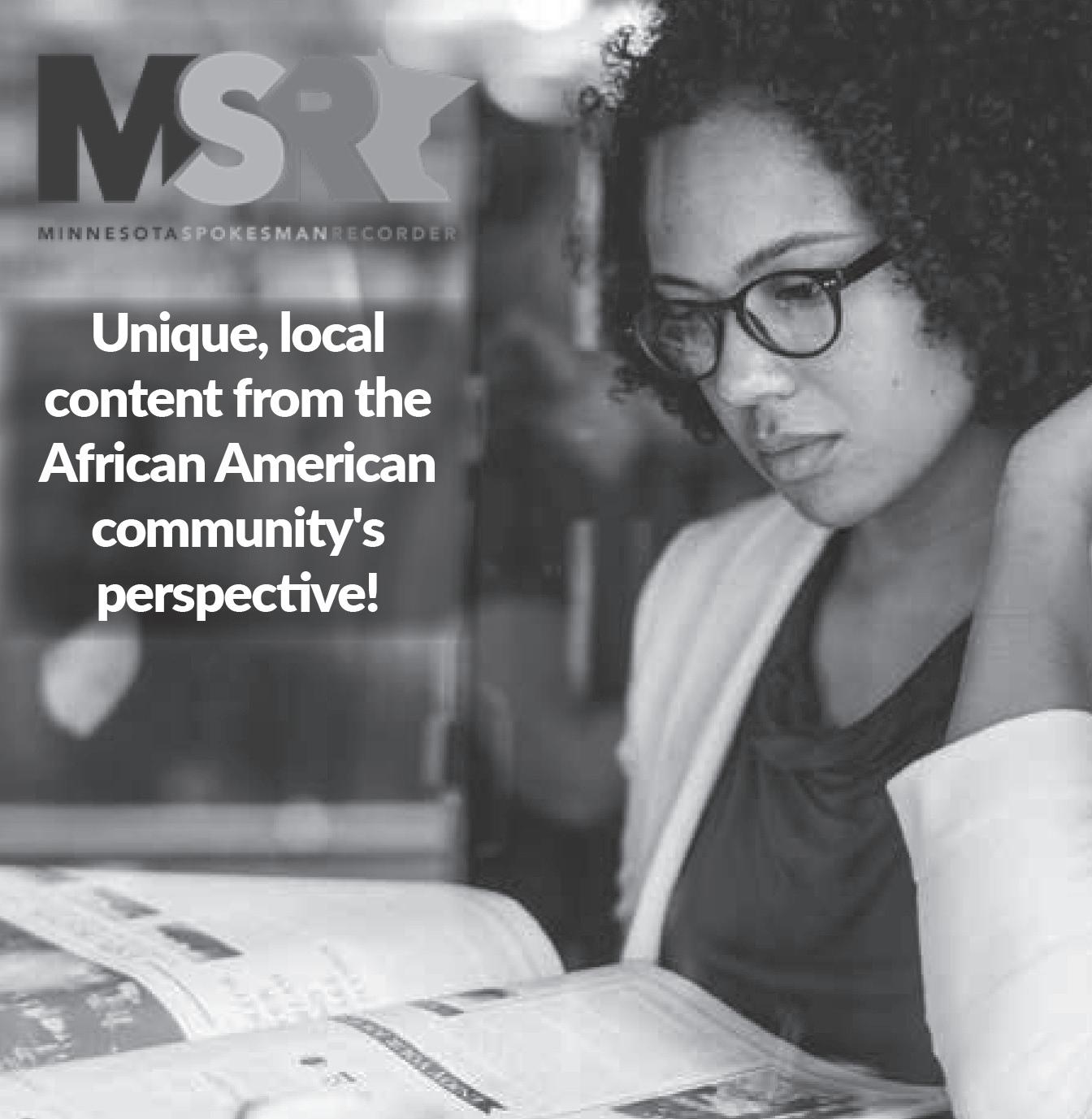


By Alexzia Shobe Staff Writer
Since opening its doors six years ago, La Doña Cervecería has been the only brewery in Minnesota known especially for honoring the Latinx community. Co-owner Sergio Manancero created a space where craft beer, cultural heritage, and community engagement intersect.
Manancero’s family tree has roots in Colonia, Uruguay, but he was born and raised in Maple Grove. It was important to his parents that he understand his lineage and how they immigrated to America in 1980. “They taught me what it meant to be Latinx in the U.S.,” he said. Growing up enmeshed in a close-knit Latinx community taught him the importance of ancestry. His parents instilled in him the value of understanding one’s background and a strong drive to succeed, fostering a sense of pride in his identity. He fondly recalled their motto: “Aim for the moon
and land among the stars.”
Manancero took that to heart. After graduating from Ossio High School in 2009, he served four years in the Marine Corps, including two deployments to Afghanistan. Returning home, he pursued a degree in sociology at the University of Minnesota, where he developed an avid interest in the sociology of beer.
“I took a class on the sociology of alcohol in my sophomore year,” he said. “I learned how the industry advertises, how different people communicate in bars, and about the archeological evidence that exists suggesting civilizations farming barley to make beer.”
Craft beer was gaining popularity, so he’d often check out local craft breweries with his friends. Those experiences left much to be desired when it came to representation.
“I wasn’t seeing Latin people in those spaces, or any people of color really. It seemed to have been built for one type of person, and I didn’t fit the bill,”

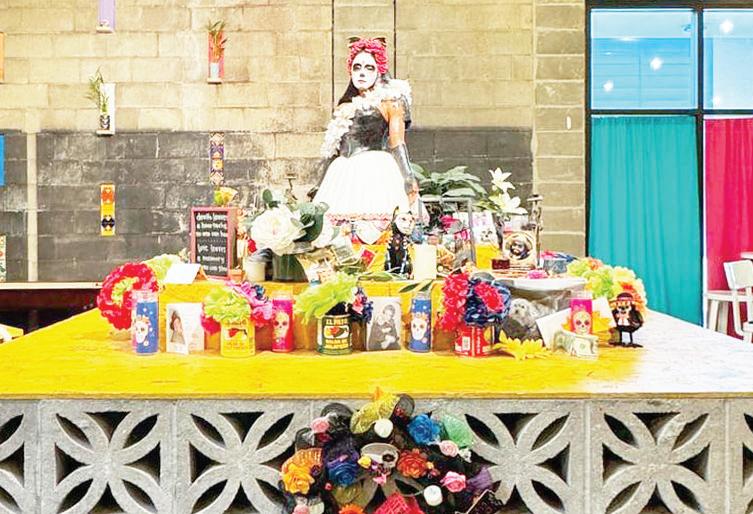
Manancero said.
Beyond the clear homogeneity of the craft beer scene, Manancero discerned an equally insular attitude among those enmeshed in that society.
“I wasn’t seeing Latin people in those spaces, or any people of color really. It seemed to have been built for one type of person, and I didn’t fit the bill.”
“This industry was very opaque. I wanted to break in and make it more accessible and easily understandable,” he said. “A big theme for us at La Doña has been accessibility. We aim to give more people access to the brewery culture and aid our Latin customers in understanding what craft beer is.”
In 2016, he resolved to diversify the brewing industry and teamed up with a friend to launch La Doña as a standalone homebrew. He put his work ethic and determina-
tion to the test, juggling a full course load with launching a small business. A year later, he left the U of M with a B.S. in sociology with a focus on law, criminology and deviance.
Shortly after graduating, he signed a lease for the building on Fremont Avenue North, where La Doña currently resides.
La Doña Cervecería was founded with a determination to uplift the Latinx community in Minnesota. From its inception, the brewery has served as a cultural hub, offering a space for celebrating Latin traditions. Programs like ¡Hablamos Pues!, a weekly Spanish conversation club, and events centered on Latin art and music showcase a clear commitment to commemorating Latinx customs. Manancero was also the visionary behind La Doña’s three-on-three soccer field, hosting weekly soccer games throughout the summer and fall months. The next tournament is scheduled to coincide with Day of the Dead on Nov. 2.
La Doña will host a Día de Muertos party. Various craft vendors will offer traditional Latin wares. A line-up of three bands will perform Latin Rock and Cumbia. A team of Mexican dancers will perform traditional dances. Alongside the festivity and entertainment will be a sculpture, “La Doña,” by artist Kordula Coleman, surrounded by candles and serving as an altar dedicated to tributing the community’s lost loved ones.
“The Latinx community is very cognizant of the people who came before us and the impact they had. We celebrate our ancestors and we call on the people in our community to recall our loved ones together,” Manancero said.
With all that La Doña offers, community engagement is clearly at the heart of its operations. Manancero emphasizes the importance of creating a welcoming environment for underrepresented groups and hosting various community events and fundraisers for local nonprofits. He has partnered with Save the Boundary Waters, various Spanish immersion schools, and a few animal-centered organizations.
This brewery is just as dedicated to uplifting its community as it is to delivering high-quality beer. La Doña offers a diverse selection of signature beers on tap, showcasing unique flavors inspired by Latin American cuisine. Among its standout drafts is the Enmolada stout, the brainchild of head brewer Dicky Lopez, which incorporates serrano peppers and chocolate that gives it a flavor similar to mole.
La Doña Cervecería has been molded into a vibrant cultural celebration with an open invitation to anyone interested in experiencing the richness of Latin heritage. As part of their commitment to their patrons, La Doña offers the La Familia Membership, providing members exclusive benefits, such as a free beer upon every visit and a deeper connection to the brewery’s mission.
La Doña Cervecería is located at 241 Fremont Ave. N. in Minneapolis. Call 612-315-4613 or visit dameladona.com.
Alexzia Shobe welcomes reader responses to ashobe@ spokesman-recorder.com.
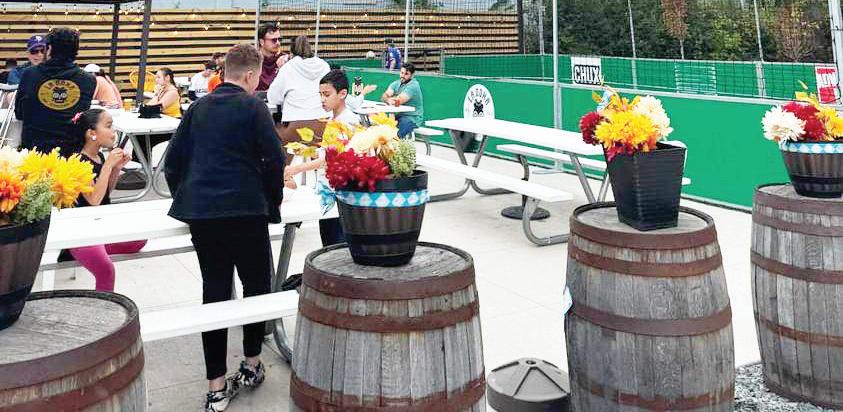

By Cynthia Moothart Managing Editor
Nearly 9,000 miles separate Minnesota and South Africa, but for filmmaker Gerri Williams, the oppressive apartheid regime of that nation’s government struck close to home.
As a young woman in the 1980s, Williams was active in the anti-apartheid movement—joining a global chorus of voices to end the brutality and release the world’s most legendary political prisoner: Nelson Mandela.
In 2018, Williams convened a series of community events in her hometown of Duluth to commemorate the liberation leader on what would have been his 100th year, to explore the lessons of reconciliation, inclusion and joy that Mandela so famously embodied. A documentary, “Duluth for Mandela: A Northland Celebration,” is the result.
The film chronicles the art, music, dance, and educational programs that brought Duluth together that year—exploring South African history, sampling the country’s cuisine, and moving to the rhythms of a South African choir.
With grants from the Duluth Superior Area Community Foundation’s Global Awareness Fund and the Duluth NAACP, Williams and her filmmaking team also interviewed local leaders who provided the context for Mandela’s message and its continued relevance today.
The film was produced at the MMAD studio, located
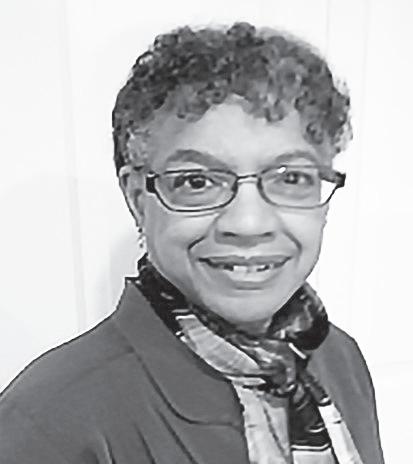
on the University of Minnesota-Duluth campus. It will be screened at the Minnesota History Center in St. Paul on Oct. 27.
“What struck me about Nelson Mandela at the time and now are the three values he reflected in life,” Williams says. She frames the three values as “transforming adversity,” “ubuntu,” and “the value of reconciliation.”
Transforming adversity:
“Here’s a man who’d been called a terrorist, been jailed, sentenced—with that sentence carried out in the worst kind of prison. His name was banned. But he transformed that time into study, along with fellow prisoners. They debated. They formed an internal college where they readied themselves to be fit to govern.”
Ubuntu: “This a Zulu word meaning ‘I am a human being through you—and vice versa.’ This is radical empathy,


rooted in a deep belief in our common humanity.”
The value of reconciliation:
“Not only in the Truth and Reconciliation Commission that Mandela authorized, but in his approach—to embrace everybody in South Africa as a multiracial democracy. That saved the country from a blood bath.”
Following the History Center screening of “Duluth for Mandela,” Williams will discuss the film with Carl Crawford, the former human rights officer for the city of Duluth and now the equity and inclusion specialist for St. Louis County.
Crawford recalls the power of those 2018 events through his association with the Clayton Jackson McGhie Memorial, on the site where three Black men were lynched in 1920. As memorial co-chair and a longtime community activist, he notes the power of community to come together and take a
stand against injustice.
“The memorial is a site of remembrance. We often get stuck between forgiveness and forgetfulness. As we refocus on the history of the U.S. and of Africa, it’s important we share those stories and remember,” he says.
“Our work is still not complete, and those events were really a call to action to move equity forward,” he continues.
“We can never forget Mandela’s life and his legacy. We must remember: Where there is injustice, there is a road to justice. And that road begins with you and I.”
Attendance is free, but registration is requested. Contact the Minnesota History Center for more information: 651-2593000.
Cynthia Moothart welcomes reader responses to cmoothart@ spokesman-recorder.com.


Protests against apartheid began peacefully, but Nelson Mandela came to believe that armed struggle was the only way forward. He and other liberation leaders established Umkhonto weSizwe—meaning “Spear of the Nation”—as the military wing of the African National Congress (ANC). The group launched in 1961 with a series of bombings across major cities.
Evading South African police forces for 17 months, Mandela eventually was arrested at a roadblock and put on trial for sabotage. While facing the death penalty, Mandela addressed the court:
“I have cherished the ideal of a democratic and free society in which all persons live together in harmony and with equal opportunities. It is an ideal I hope to live for and to achieve. But if needs be, it is an ideal for which I am prepared to die.” Mandela and seven others were convicted and sentenced to life in prison. Mandela ultimately served a 27-year term.
that he renounce violence as a political tool—an offer Mandela rejected.
As political violence roiled near the point of civil war, Mandela was released without conditions on Feb. 11, 1990. He was 71.
Addressing crowds gathered at Cape Town City Hall that day, Mandela offered words of liberation and reconciliation, burnishing his standing as a statesman for the ages:
“I stand here before you not as a prophet, but as a humble servant of you, the people.”
“I greet you all in the name of peace, democracy and freedom for all. I stand here before you not as a prophet, but as a humble servant of you, the people. Your tireless and heroic sacrifices have made it possible for me to be here today. I therefore place the remaining years of my life in your hands.” South Africa adopted an interim constitution in 1993— the same year Mandela was awarded the Nobel Peace Prize—paving the way for the country’s first democratic elections.
With Mandela imprisoned, South Africans continued to resist the violent apartheid regime. Under increasing global pressure, the minority-white government offered to release Mandela in 1985 on the condition
One year later the ANC swept into power, garnering 63% of the vote. Mandela stepped down from the presidency after one term, but he would dedicate his remaining days to transforming the country to which he’d already given so much of his life.



By Alexzia Shobe Staff Writer
Roger Guenveur Smith— known for his collaborations with Spike Lee and his role inthe hit HBO series “Oz”—will perform his one-man show honoring his old friend JeanMichel Basquiat at Penumbra Theatre through Oct. 27.
Before Smith was an awardwinning actor and Basquiat became a groundbreaking artist, they were simply two Black boys striving to lead a happy and purposeful life. About 3,000 miles and five years apart, these two visionaries came into existence just in time for the crucible of the Civil Rights Movement and the emergence of a new counterculture.
The confluence of these events created an environment in which each could flourish to their full potential: Smith, born in 1955 in Berkeley, California, to two African American parents; and Basquiat, born in 1960 in downtown Brooklyn to Haitian immigrants. Two transcendent souls sprung up on opposite coasts yet developed the same hunger for peace, joy, and substantive change.
Basquiat’s creative genius manifested at a young age. He explored expression through every art form he could—creating everything from resplendent crayon drawings to graffiti poetry and music. His dalliance into the no wave music scene, an ephemeral, avant-garde rejection of punk, led him to Michael Holman, with whom he founded the experimental band GRAY in 1979.
This solidified the connec-
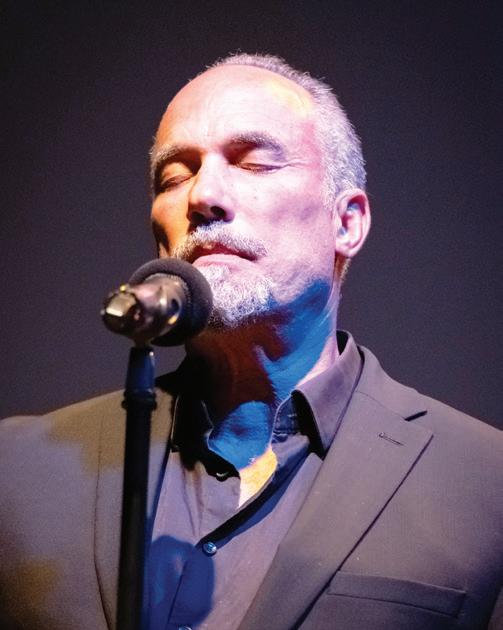
my performance, but go on to seek out his work and be inspired to pursue kindness, love, joy and happiness.
“He was a friend of mine. It’s called ‘In Honor of JeanMichel Basquiat’ because I continuously feel the need to pay tribute to him, investigate his work and life, and present his work to new generations of art lovers. Basquiat’s life was an exemplary tribute to the art world and revolutionary consciousness,” Smith adds.
tion between Basquiat and Smith, who also knew Holman from the L.A. party scene.
“The first thing Basquiat said to me when we met was, ‘I really like your energy,’” Smith says. Their relationship quickly blossomed after meeting in 1982 as they both propelled forward in their artistic endeavors.
“He had a very strong symbolic consciousness, and he wasn’t afraid to act on it.”
Their camaraderie was rooted in mutual respect and a shared commitment to challenging the status quo.
In his play, Smith emphasizes the importance of reexamining Basquiat’s life beyond the tragedy of his early death at 27. “I hope it’s a reconsideration of who the artist was,” Smith says. “That folks will walk out not mourning the tremendous loss or admiring
He doesn’t simply pay tribute to Basquiat through the retelling of old stories; Smith highlights every aspect of his vibrant presence. The role of music and visual art in Basquiat’s life—and subsequently in Smith’s performance—cannot be overstated.
“Basquiat always worked with stimulants in his studio. There was always music playing, a book that was open, or something on his television screen,” Smith says. This electrifying environment served as a backdrop for Basquiat’s creativity, which Smith mirrors in his production through close collaboration with sound designer Marc Anthony Thompson.
The musical landscape of the performance echoes the energetic spirit of Basquiat’s life, intertwining sound with storytelling. The set design also plays a crucial role.
Smith and his team use a stark white environment, punctuated by a central Basquiat crown, creating a canvas upon which emotions and stories are projected. This visual simplicity allows the audience to focus on the depth of the narrative and emphasizes
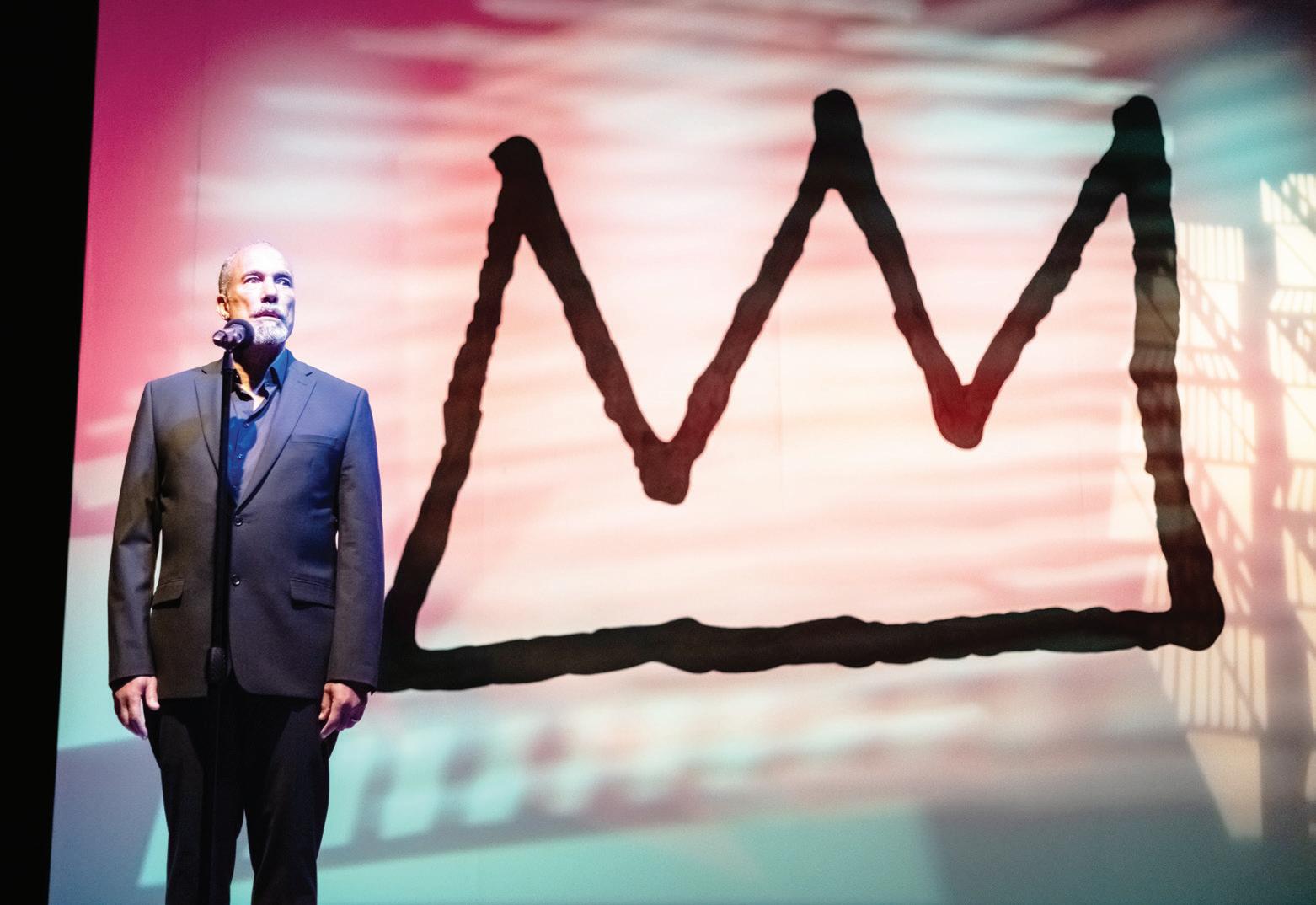

lighting designer Wu Chen Khoo’s aurora borealis-inspired color schemes projected on the stage.
Although Smith stands alone on the stage, he asserts that this is not your typical one-man show. Along with the crucial roles of Thompson and Khoo, the audience is integral to production.
“It’s not a solo performance. We’re all in the same room and on the best level are in collaboration with each other emotionally, politically and comically,” Smith says. He uses the intimate setting of the theater to enrapture and educate the audience, playing off the participation of those in attendance to delve deeper into the enigma he portrays.
Basquiat’s legacy is intertwined with his cultural heritage, and Smith emphasizes the importance of this context.
“[Basquiat] really challenged us to consider the ongoing resonance of our collective history as Africans in the new world,” Smith says.
Growing up in a diverse environment, Basquiat absorbed a cosmopolitan and multilingual worldview that enriched his artistic output. His works often grapple with themes of race, identity, and social justice—issues that remain profoundly relevant today.
In one powerful scene, Smith recounts a moment when he and Basquiat encountered a young man wearing a denim jacket adorned with a

Confederate flag. Basquiat’s immediate reaction—taking the jacket, throwing it on the ground and stomping on it— demonstrates his refusal to accept hatred in his space.
“He had a very strong symbolic consciousness, and he wasn’t afraid to act on it,” Smith says. This anecdote serves as a powerful reminder of Basquiat’s activism and resistance, elements integral to his work.
Ultimately, Smith’s performance is not merely a tribute; it is a call to action. “There’s triumph there that is important to impart as well as tragedy,” he says. “The tragedy, of course, speaks for itself. I’d like the triumph to speak for itself as well, because we’re still engaged in Basquiat’s work and will continue to be for generations ahead.”
As audiences gather to experience “In Honor of JeanMichel Basquiat”, they are invited to reflect on the life of an extraordinary artist and to engage with identity, resistance, and the transformative power of art. In a world rife with challenges, Basquiat’s legacy remains a beacon of hope and inspiration, reminding us all to seek beauty, truth, and meaningful connection in our lives. For ticketing information and more,


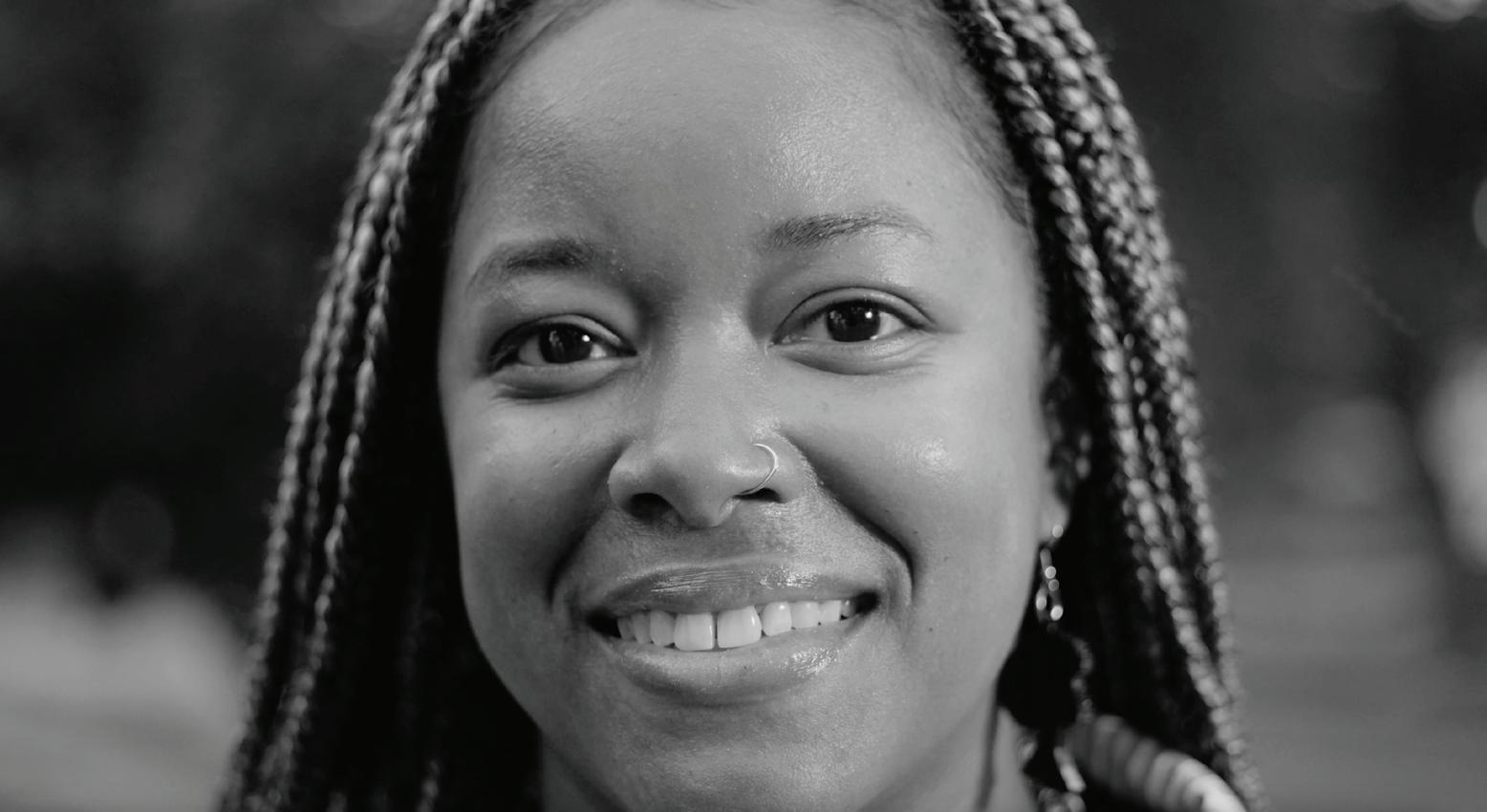
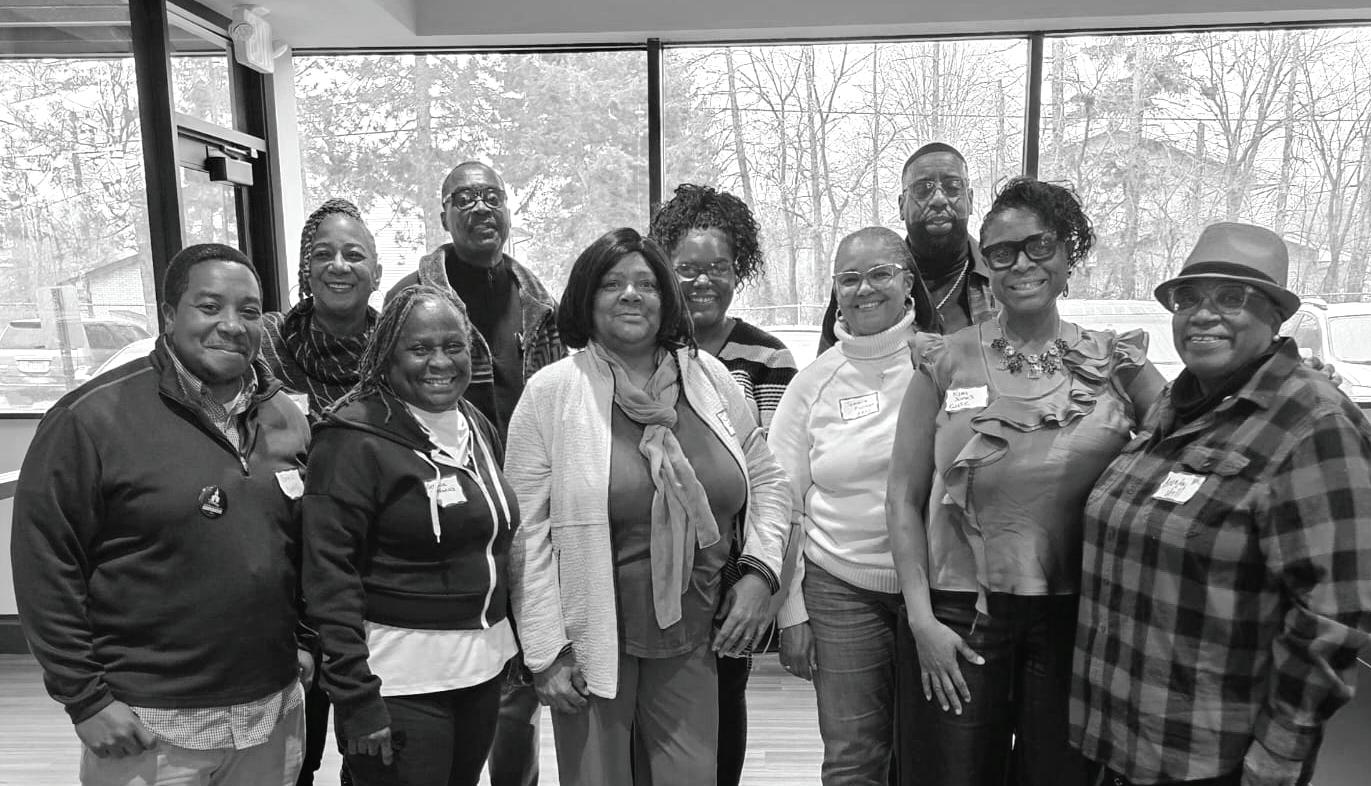
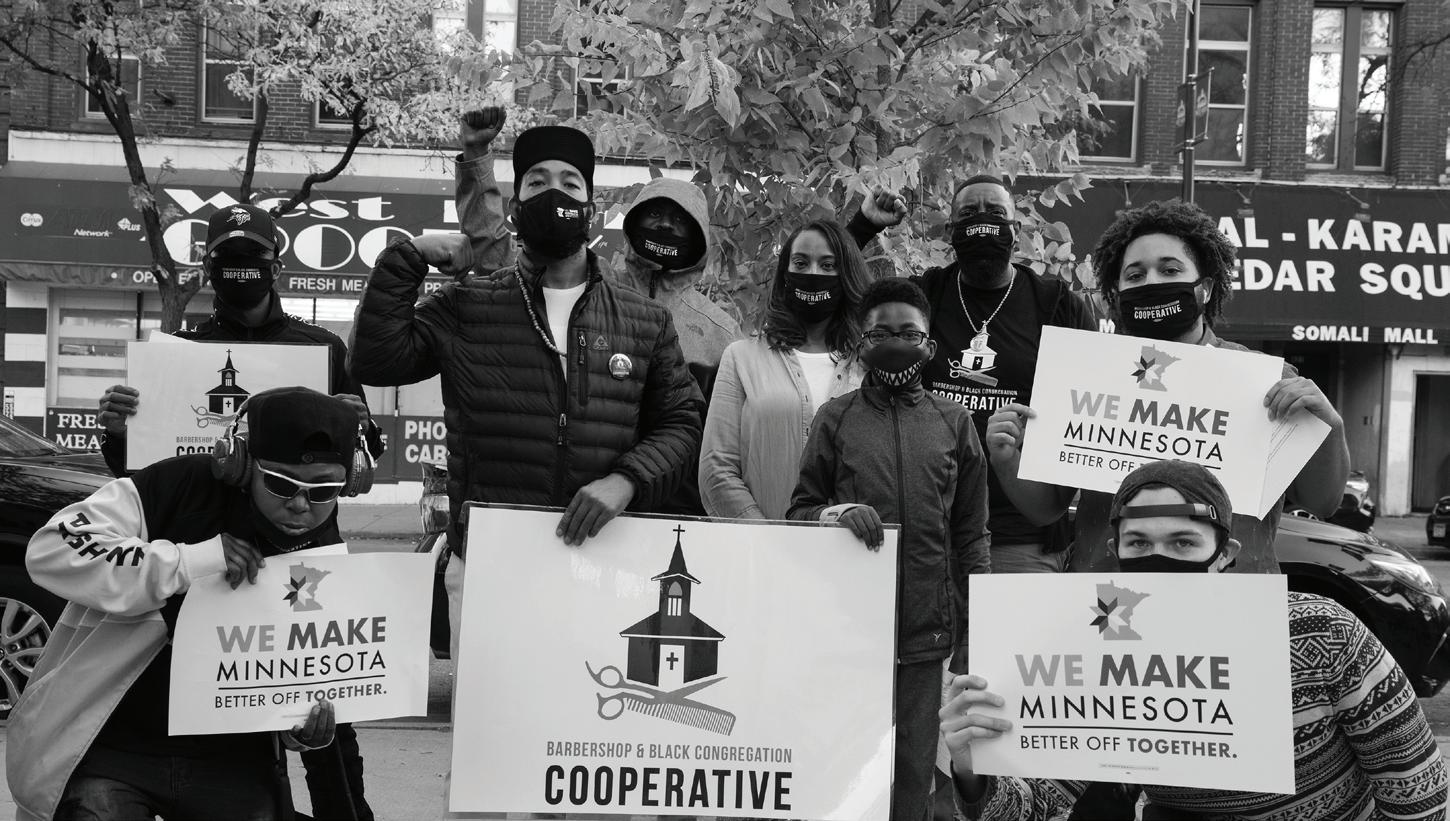
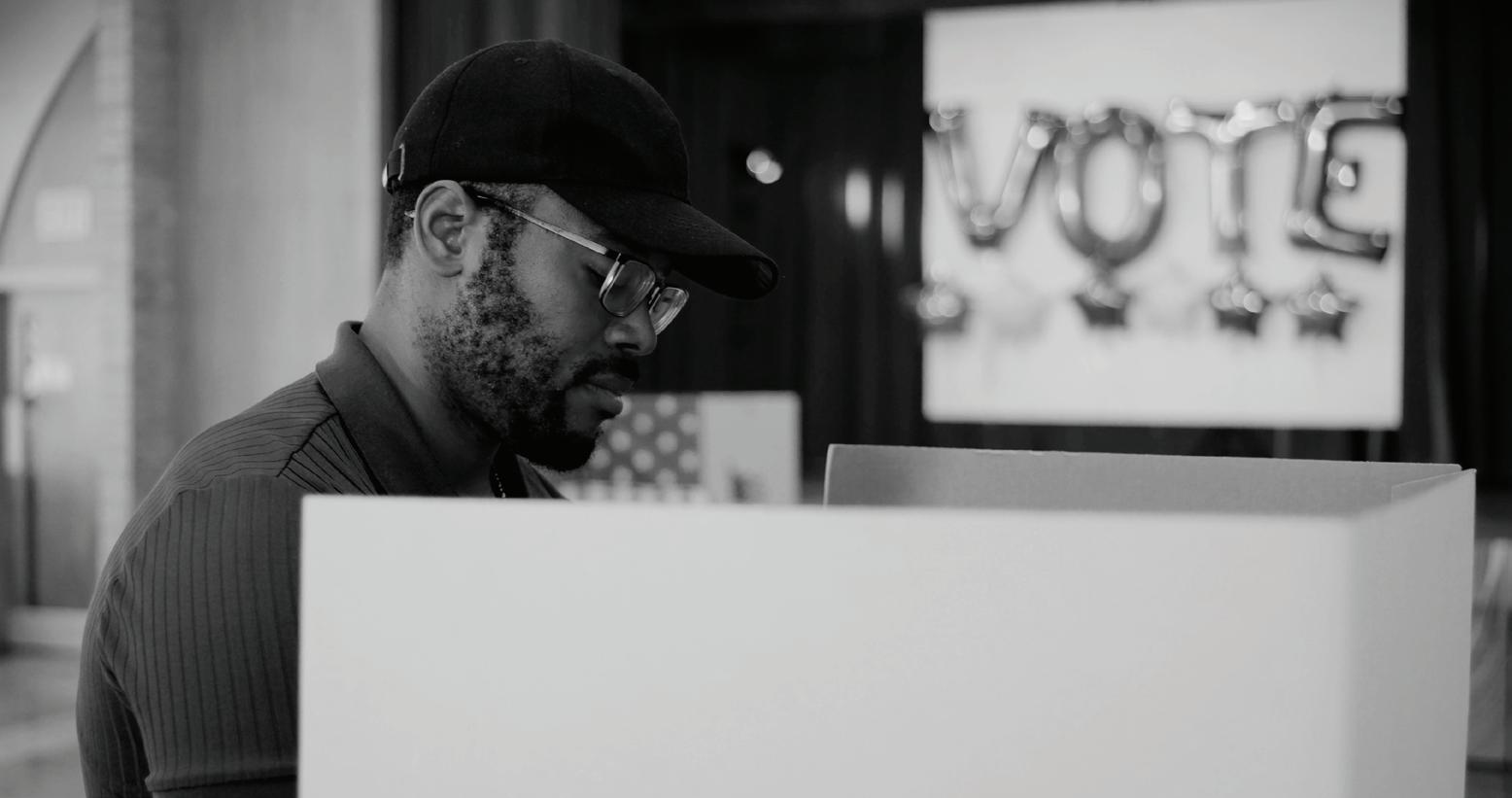




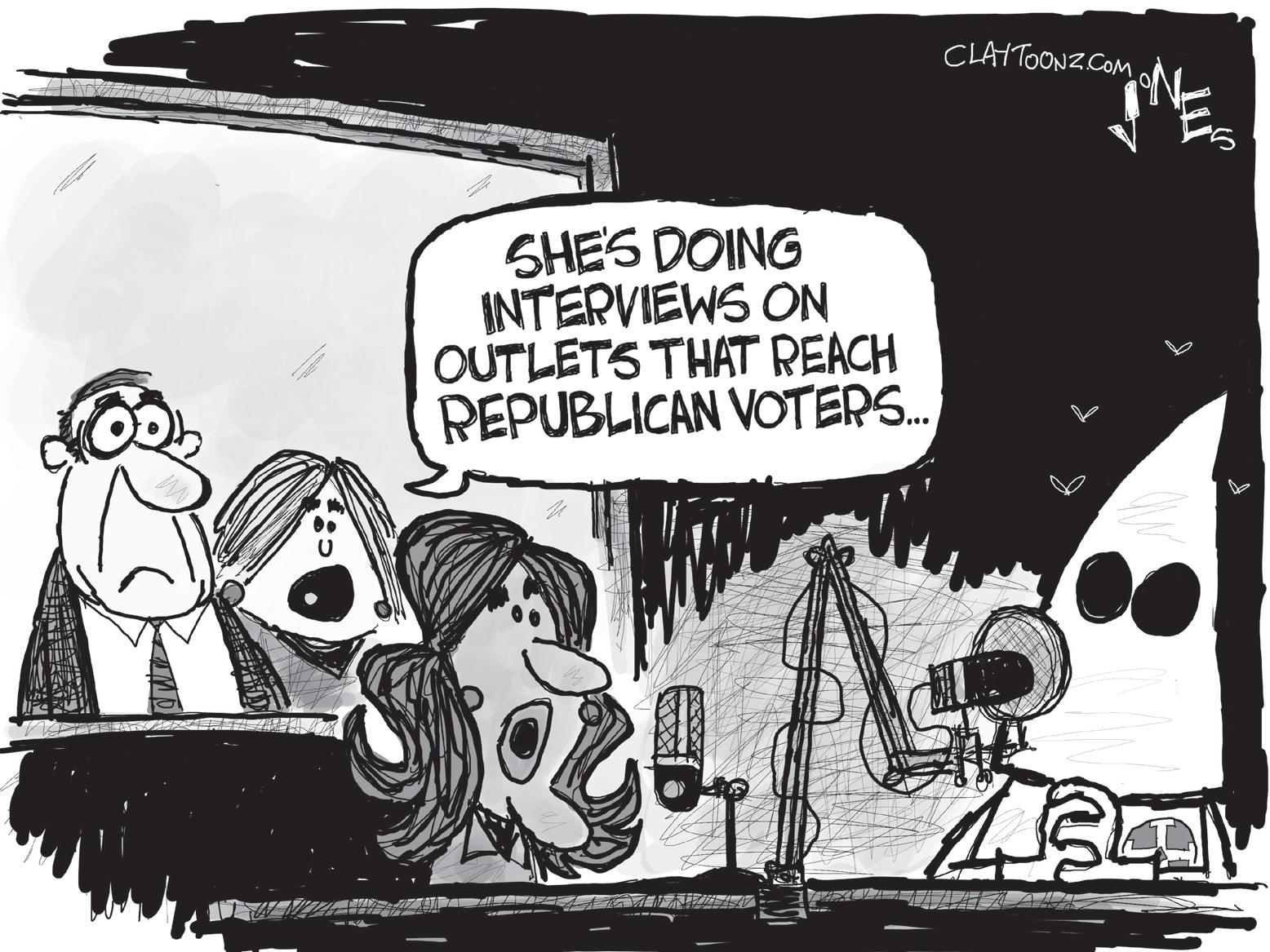
By Stacy M. Brown
The 2024 presidential race between Vice President Kamala Harris and former President Donald Trump underscores a profound clash on race and justice. Trump, the twice-impeached Republican nominee who next month faces sentencing in New York for 34 felony convictions, has called for greater police authority and protections, stirring deep fears within Black and minority communities already grappling with systemic racism and violence.
His recent statements supporting qualified immunity and endorsing lethal force against perceived enemies reveal a hardline stance that threatens the very fabric of civil rights gains in America.
Trump’s divisive rhetoric is nothing new. His call for the death penalty for five Black and Latino men—exonerated in the infamous Central Park jogger case—casts a long shadow. In stark contrast, Vice President Harris, a former prosecutor, has spoken out against Trump’s inflammatory language and is advocating for a justice system that is fair and equitable for all.
Harris has argued that Trump’s words have exacerbated racial tensions and could lead to further violence against communities of color. Recent highprofile cases highlighting racial discrimination and power abuse within law enforcement have heightened these concerns.
In Las Vegas, a grand jury recently indicted Sgt. Kevin Menon on multiple counts, including nine charges of oppression under color of office. The charges reveal a disturbing pattern of
false arrests primarily targeting Black men.
Menon, now suspended, allegedly orchestrated unlawful arrests by provoking situations without probable cause, aiming to manipulate crime statistics.
Menon’s actions, now under scrutiny, have drawn attention to the broader issue of racial profiling and abuse within police forces nationwide.
The DOJ’s involvement in such cases underscores the urgent need to address systemic racial violence. In Kansas, Austin Schoemann was sentenced to more than six years in prison for a series of racially motivated threats against Black individuals, including two juveniles and a woman he believed was associating with Black people. Schoemann’s campaign of ter-
recently agreed to an $8 million settlement following allegations of redlining in Black neighborhoods in Birmingham, Alabama.
This settlement is part of the DOJ’s broader Combating Redlining Initiative, which has provided more than $150 million in relief to affected communities. The Fairway case marks another chapter in the DOJ’s fight to dismantle discriminatory lending practices that have denied Black Americans equal access to housing.
As Election Day approaches, voting rights continue to be a flashpoint. The DOJ has filed lawsuits against Virginia and Alabama for voter purges targeting minority communities, raising concerns of disenfranchisement.
In Virginia, the DOJ alleges that the state violated the Na-
“We don’t want a leader who is constantly trying to have Americans point their fingers at each other.”
ror involved threats of violence and the brandishing of firearms, all aimed at instilling fear within the Black community.
In another recent case of racial violence, former Louisiana sheriff’s deputy Javarrea Pouncy was sentenced for using excessive force against a detainee, severely injuring the man in a brutal assault that left him with a broken eye socket and nose.
Pouncy’s conviction, resulting from a 2019 incident, highlights the DOJ’s ongoing efforts to hold law enforcement officers accountable for abuses of power. Beyond violent acts, systemic discrimination persists within the financial sector. Fairway Independent Mortgage Corp.

By ReShonda Tate
The fear of strong Black women in politics isn’t a new phenomenon—it’s deeply rooted in both systemic racism and sexism. We saw it on full display recently when a Trump surrogate, challenged by a CNN commentator about whether he knew any strong Black women, fumbled and failed to answer the question.
This moment was telling, not just because he couldn’t name a single Black woman, but because it highlighted a broader societal discomfort with Black women’s strength, particularly when they occupy positions of power.
In 2024, as political campaigns heat up, we’re witnessing attempts to discredit Black women in leadership reach unprecedented levels. Kamala Harris, despite being the most qualified candidate on the ballot with a resume that includes attorney general and vice president, faces constant attacks on her competence and character. If she speaks on issues of race—whether about the Black community or justice system inequities—her critics pounce, twisting her words to stoke division.
This type of scrutiny is a burden that Black women have carried for generations in politics. It’s the double bind we navigate: Stay silent and be deemed ineffective, or speak up and be accused of “racebaiting.”
The fear and vilification of Black women speaking truth to power isn’t just happening on the national stage—it’s also playing out in local races, like in Fort Bend County, Texas. Take
Judge Tameika Carter, presiding judge of the 400th District Court, who recently made a poignant observation during a candidate forum about how “tough-on-crime” policies disproportionately impact Black and brown communities.
As a judge, she has seen firsthand how systemic inequities continue to harm marginalized communities, and she courageously called attention to this truth. But instead of engaging with the substance of her remarks, Republican opponents quickly labeled her statements as “divisive.”
are not, accusing her of using race as a weapon. It’s an intentional strategy to paint Black leaders as instigators of division while conveniently ignoring the root causes of the disparities they point out.
But here’s the thing: Voters are smarter than these tactics. They understand that conversations about criminal justice reform and equity aren’t “racebaiting”—they’re necessary for building a fairer society. People want leaders who will confront hard truths and fight for justice for all, not just the privileged few.
This isn’t just about one candidate or one race—it’s part of a broader effort to undermine Black women in positions of power.
But this isn’t just about one candidate or one race—it’s part of a broader effort to undermine Black women in positions of power. When Judge Carter speaks about injustice, it’s labeled as “race-baiting.”
When Kamala Harris advocates for the marginalized, it’s dismissed as divisive.
This is the cross we bear as Black women in politics: We are expected to fight for equity without ever addressing the inequities that directly impact our communities.
This type of attack relies on the same old playbook. Instead of grappling with the tough issues Judge Carter raises—like systemic inequality in the justice system—her critics twist her words into something they
The fear of strong Black women in politics stems from our willingness to challenge the status quo, speak truths that make people uncomfortable, and demand change where it’s long overdue. But this fear won’t stop us. We’ve come too far and accomplished too much. And no matter how hard they try to silence us, we will continue to rise because strong Black women are exactly what this country needs.
ReShonda Tate is a journalist and best-selling author of books including “Let the Church Say Amen,” which was made into a film directed by
submissions@spokesman-recorder.com submissions@spokesman-recorder.com submissions@spokesman-recorder.com.
tional Voter Registration Act’s “quiet period” by removing voters too close to the election, risking widespread confusion. Alabama’s actions led a federal court to order the reinstatement of purged voters, ensuring that eligible individuals can participate in the electoral process.
Federal observers have been deployed to monitor critical areas’ compliance with civil rights laws. The Justice Department has committed to protecting the right to vote, and officials have stated that they recognize the high stakes for communities of color in an election where race has become a central issue.
Harris has called for unity and an end to divisive rhetoric, warning that a Trump presidency could further erode the nation’s commitment to civil rights. “We don’t want a leader who is constantly trying to have Americans point their fingers at each other,” Harris said.
“I meet with people all the time who tell me, ‘Can we please just have discourse about how we’re going to invest in the aspirations, ambitions and dreams of the American people?’ Knowing that regardless of people’s color or the language their grandmother speaks, we all have the same dreams and aspirations and want a president who invests in those, not in hate and division.”
Stacy M. Brown is a senior writer for The Washington Informer and the senior national correspondent for the Black Press of America. Brown has more than 25 years of journalism experience and has authored two major biographies, including “Blind Faith: The Miraculous Journey of Lula Hardaway, Stevie Wonder’s Mother.”
The right to vote protects all other
By Colin Allred
Voting is one of our most fundamental rights. It’s not just about having a say in the future of our country; it’s about honoring the legacy of those who fought and sacrificed so that we could have a voice. As a voting rights lawyer, I’ve seen the impacts of voter suppression firsthand and know how deeply un-American it is when folks cannot vote because of arbitrary barriers put in place to make it harder.
Americans can participate in our democracy, we must expand early voting, make Election Day a federal holiday, and take steps like same-day voter registration that make voting more accessible, not create barriers that harm it.
“The vote is precious. It is almost sacred. It is the most powerful nonviolent tool we have in a democracy.”
I became a voting rights attorney because I believe the right to vote is preservative of all other rights. That’s why we cannot afford to sit on the sidelines.
In Congress, I’ve been working to reinstate and modernize the Voting Rights Act to stop harmful voter suppression laws. To ensure more
I’ve introduced legislation to ensure integrity in our elections and to protect our election workers. I stand by the words of my hero, Congressman John Lewis, who said, “The vote is precious. It is almost sacred. It is the most powerful nonviolent tool we have in a democracy.”
Despite these efforts, laws passed across the nation now make it harder for Americans to vote by mail, limit early voting hours, and have burdensome voter registration and voter ID provisions. The Voting Rights Act of 1965, championed by the Civil Rights Movement, was
signed into law to expand the vote.
Congress has reauthorized the Voting Rights Act multiple times since its passage. In 2006, reauthorization passed both chambers of Congress with wide bipartisan support— and passed unanimously in the Senate. More recent voter suppression laws are an assault on this legacy.
History has shown us that just a handful of votes can decide elections. We have less than a month to turn out our family and friends and ensure that every eligible American can cast their ballot.
It’s time to decide to vote, especially at a moment when anti-democratic voting laws threaten the principles our country was founded on. I often say if you’re not at the table, you’re on the menu.
Voting is our power and our voice. Let’s use it.
Colin Allred is an American politician, civil rights lawyer, and former professional football player serving as the U.S. representative from Texas’s 32nd congressional district since 2019. He is running for U.S. Senate against Ted Cruz in the 2024 elections.

By Tannistha Sinha
In October 2015, a Black 16-year-old in Spring Valley High School, South Carolina, was trapped in a headlock, flipped over, and dragged across her classroom by a school police officer when she refused to surrender a cellphone. Her classmates recorded the incident on their phones. One of those videos went viral, and Deputy Sheriff Ben Fields, called “Officer Slam” by students, was exposed.
However, the girl and her classmate who recorded the video were arrested and sent to juvenile detention on the grounds of “disturbing a school function,” a law later ruled to be unconstitutionally vague.
A report by the Advancement Project analyzed 460 school policing assaults against students by police officers and security guards in the 2023-24 school year. It found that 1,072 students were assaulted between the 2013-14 and 2023-24 school years, and Black students comprise 84% of school policing assault victims.
The report, “#AssaultAt: The Legacy of Lynching in School Policing,” was written by Tyler Whittenberg, deputy director of the Opportunity to Learn Program at the Advancement Project, and Kaneesha Johnson, postdoctoral fellow at the University of North CarolinaChapel Hill.
“The alarming spike in as-
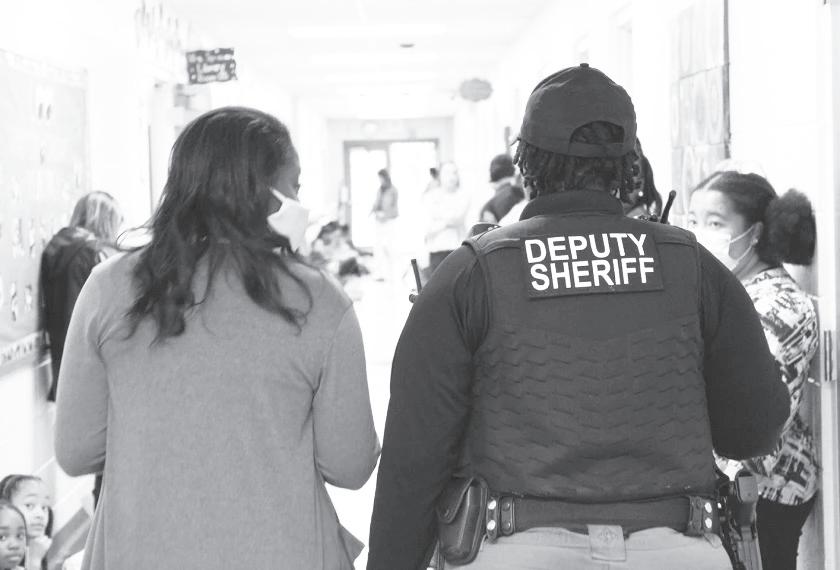
saults against students by school police and security guards underscores the troubling reality that our schools are not safe, equitable or nurturing environments for students, particularly for Black and disabled youth,” Whittenberg said.
“They are quite the opposite. Instead, students are going to school each day in fear of policing assaults, sexual violence, and criminalization.”
The study compares data
from two lynching datasets from 1882 to 1936. Its aim is to assess the correlation
between the Southern era of lynching and modern violence against students by school police and security guards, which disproportionately targets Black people.
With a rise in the frequency of lynchings in a county, the number of policing assaults also rose. For example, for every additional 100 lynchings in a county, an additional four students are assaulted, with Black students making up a majority of them.
Moreover, more than half (56%) of such assaults occurred in Black and Latino ma-
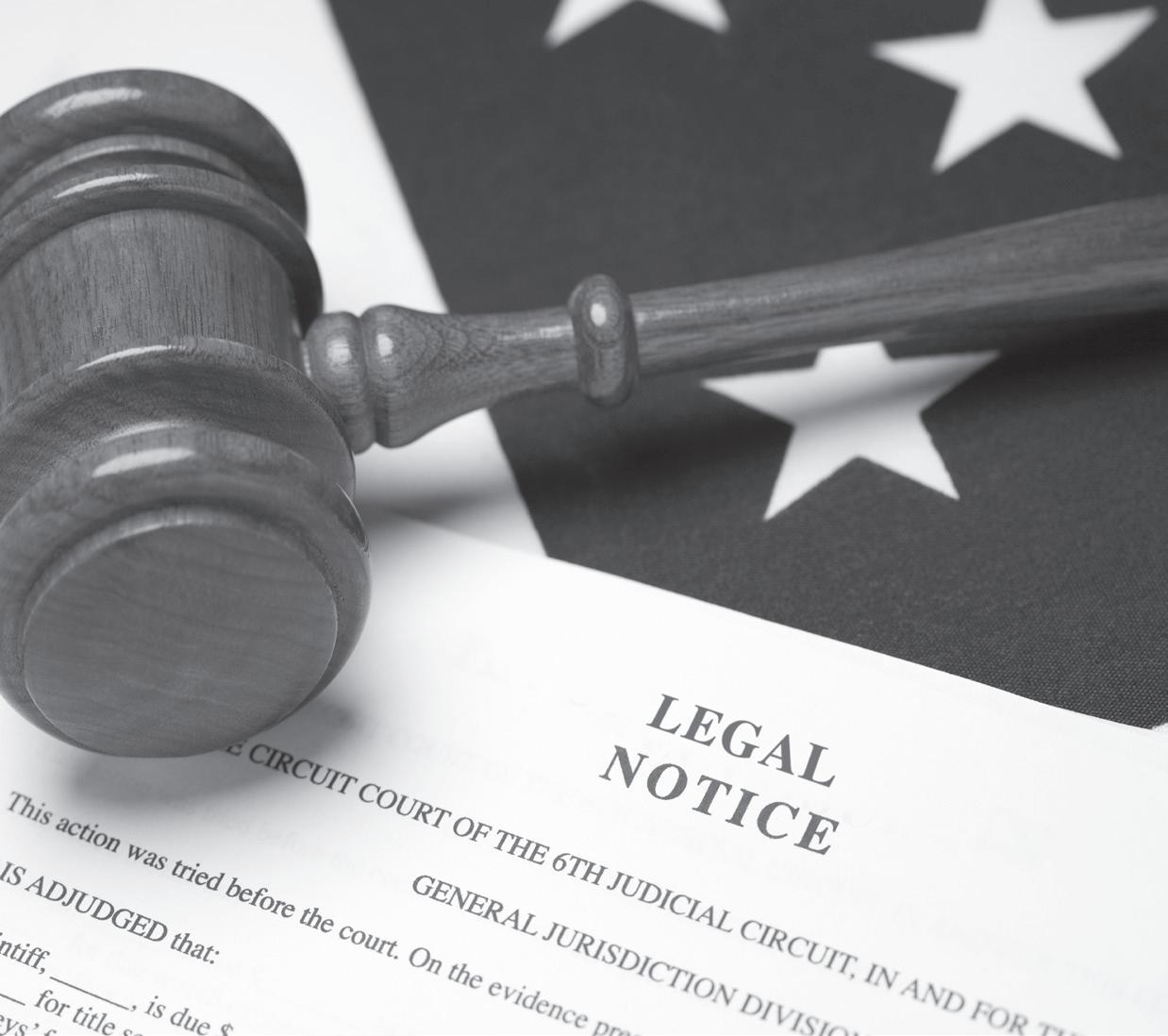

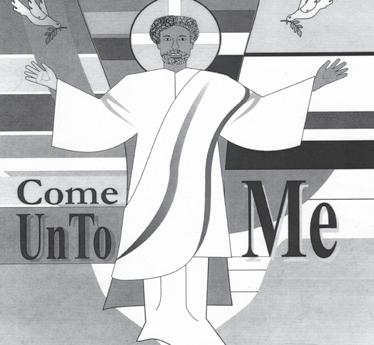
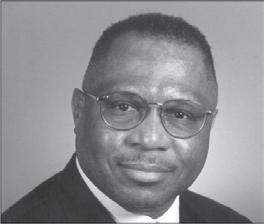




jority schools. Again, schools in the South make up the bulk (54%) of those experiencing policing assaults.
“This report reveals a deeply entrenched legacy of racial violence rooted in historical lynchings and its link to modern policing practices in our educational institutions. It’s time to dismantle the myth that policing makes schools safer and confront the systemic injustices that put our most vulnerable students at risk,” Whittenberg added.
Assaults methods:
• Physical assaults (39%)
• Assaults with a weapon (35%)
• Sexual assaults (25%)
The study focuses on the key aspect behind such discriminatory behaviors toward Black students: Police officers perceived Black boys as four and a half years older than their actual age and less childlike than white boys of the same age, according to a study. Moreover, adults perceive Black girls as less innocent and do not need as much support and protection as their white peers.
The authors argue school policing will not reduce violence but will, instead, increase the number of Black students to be pushed out of schools, arrested, and placed in youth and adult criminal legal systems.
This article originally appeared in the Houston Defender.


As the Minnesota Spokesman-Recorder approaches its 90th anniversary, you’re invited to commemorate this historic milestone by donating $90 to celebrate 90 years of continuous publication.
As the Minneapolis Spokesman-Recorder begins its 90th Anniversary year, you’re invited to commemorate this historic milestone by donating $90 to celebrate 90 years of continuous publication.
Your generous contribution will support our legacy of dedicated community empowerment through journalism and ensure our vital work continues into the future.
As a “$90—for- 90” contributor (non-business), your name will be prominently displayed in our print and digital editions until the week of Aug. 10, 2025. The paper was founded on Aug. 10, 1934.
As a “$90-for-90” contributor (non-business), your name will be prominently displayed in our print and digital editions until the week of Aug. 10 — the date of our founding in 1934.
Please consider this unique opportunity to stand collectively with the MSR, honoring 90 years of tradition and community service. For inquiries or to join as a “$90-for-90” supporter, call 612-827-4021, visit our website, or email admin@spokesman-recorder.com.
Anita Alexander
Ray Seville Productions
Torrion Amie
Kimerlie Geraci
Holly Andersen
David Fettig
Nancy L. Beals
Tracy Wesley
Jonathan Beck
The O’Neill Family
Clara Boykin & Family
Liam Cavin
Gretchen Bratvold
Amanda Brinkman
Your Name Here
Toweya Brown-Ochs
Your Name Here
Benjamin F. Bryant & Dr. Antusa S. Bryant
Your Name Here
Deanna Callender
Your Name Here
Shirlee L. Callender
Your Name Here
Karl Cambronne
Your Name Here
Liam Cavin
Your Name Here
Janis Clay
Your Name Here
Edward Coblentz
Your Name Here
Coventry Cowens
Michael Davis
Your Name Here
Victoria Davis
Your Name Here
Michael Diehl
Your Name Here
April A. Estes
Your Name Here
George Ewing
Your Name Here
Elizabeth Fealey
Your Name Here
David Fettig
Your Name Here
Readus Fletcher
Your Name Here
Ken Foxworth
Your Name Here
Your Name Here
Michael Franks
Lee Friedman
Your Name Here
Ella Gates-Mahmoud
Your Name Here
Kimerlie Geraci
Your Name Here
Erick Goodlow
Your Name Here
Leota Goodney
Your Name Here
Karlene Green
Your Name Here
Pamela Hall-Clemens
Jeana Hamm
Your Name Here
Hendon Group, Inc
Your Name Here
Ellen Guettler & Ben Pofahl
Your Name Here
Colnese Hendon
Your Name Here
Connie Hudson
Your Name Here
Angelo Hughes
Your Name Here
Andrew Issacson
Your Name Here
Katie Izzo
Your Name Here
Nina Johnson
Clarence Jones
Your Name Here
Debra Jones
Your Name Here
Shirley R. Jones
Your Name Here
Cynthia Kelly & Murry Kelly Jr.
Your Name Here
Nathaniel Khaliq
Your Name Here
Zena Kocher
Your Name Here
Jimmy Lewis
Your Name Here
Lisa Lissimore
Your Name Here
Michele Livingston
Your Name Here
Harlan Luxenberg
MRPP and Associate
Your Name Here
Communications
Melanie Manaen
Your Name Here
Peter McLaughlin
Your Name Here
Kyle Meerkins
Your Name Here
Deborah Montgomery
Your Name Here
Debbie Morrison
Your Name Here
Marcia Murray
Your Name Here
Mary K. Murray Boyd
Dan Ness
Your Name Here
Sanda Noy
Your Name Here
The O’Neill Family
Your Name Here
Minister Dr. Ni Ora Hokes
Your Name Here
Liz Oppenheimer & Jeanne Burns
Your Name Here
Ray Seville Productions
Your Name Here
Mary Quinn McCallum
Your Name Here
Amy Pfankuch
Your Name Here
Patty Ploetz
Mark Ritchie
Your Name Here
Lyn Rabinovitch & John Saxhaug
Your Name Here
Augustus Ritemon
Your Name Here
Carolyn Roberson
Your Name Here
Winthrop & Barbara Rockwell
Your Name Here
M. Rebecca Ross
Your Name Here
St. Paul Saints
Your Name Here
Floyd Smaller
Your Name Here
Chanda Smith Baker
Your Name Here
South Hill Film
Ronald Spika
Your Name Here
Cyriaque Sukam
Your Name Here
Timothy Sullivan
Your Name Here
Heidi Swank
Your Name Here
Dotty Timmons
Your Name Here
Nicholas Upton
Jason Walker
Your Name Here
Dr. Betty Webb
Your Name Here
Bill Wells
Your Name Here
Tracy Wesley
Your Name Here
Jeffery Young
Your Name Here
Your Name Here
Your Name Here
Your Name Here
Your Name Here
Your Name Here
Your Name Here
Your Name Here
Your Name Here
Your Name Here
Your Name Here
Your Name Here
Your Name Here
Your Name Here
Your Name Here
Your Name Here
Your Name Here
Your Name Here
Your Name Here
Your Name Here
Your Name Here
Your Name Here
Your Name Here
Your Name Here
Your Name Here
Your Name Here
Your Name Here
Your Name Here
Your Name Here
From Ads Department/MN Spokesman-Recorder
Court File No. 27-PA-PR-24-1197
Plaintiff, vs. SUMMONS
Radu Lungu, Defendant.
THIS SUMMONS IS DIRECTED TO the above-named Defendant:
I. YOU ARE BEING SUED. The Plaintiff has started a lawsuit against you. The Plaintiffs Complaint against you is attached to this summons. Do not throw these papers away. They are official papers that affect your rights. You must respond to this lawsuit even though it may not yet be filed with the Court and there may be no court file number on this summons.
PHONE: 612-827-4021
NOTICE AND ORDER FOR HEARING ON PETITION FOR FORMAL PROBATE OF WILL AND APPOINTMENT OF PERSONAL REPRESENTATIVE AND NOTICE TO CREDITORS
FOR BILLING INQUIRIES & TEARSHEETS
In re the Estate of: Martha Juanita Brun, Decedent.
PLEASE CONTACT
ACCOUNTING DEPT @ BILLING@SPOKESMAN-RECORDER.COM
From Ads Department/MN Spokesman-Recorder
PHONE: 612-827-4021
FOR BILLING INQUIRIES & TEARSHEETS
PLEASE CONTACT
ACCOUNTING DEPT
BILLING@SPOKESMAN-RECORDER.COM
PROBATE FLAT FEE: $215.00
The MSR handles billing digitally. This means you will get e-tears and e-mailed invoices unless you specifically request a copy. STATE
2. YOU MUST REPLY WITHIN 20 DAYS TO PROTECT YOUR RIGHTS. You must give or mail to the person who signed this summons a written response called an Answer within 20 days of the date on which you received this Summons. You must send a copy of your Answer to the person who signed this summons located at: Brantingham Law Office, P.A. 2200 E Franklin A venue, Suite 202 Minneapolis, MN 55404
3. YOU MUST RESPOND TO EACH CLAIM. The Answer is your written response to the Plaintiff’s Complaint. In your Answer you must state whether you agree or disagree with each paragraph of the Complaint. If you believe the Plaintiffs should not be given everything asked for in the Complaint, you must say so in your Answer.
4. YOU WILL LOSE YOUR CASE IF YOU DO NOT SEND A WRITTEN RESPONSE TO THE COMPLAINT TO THE PERSON WHO SIGNED THIS SUMMONS. If you do not Answer within 20 days, you will lose this case. You will not get to tell your side of the story, and the Court may decide against you and award the Plaintiff everything asked for in the Complaint. If you do not want to contest the claims stated in the Complaint, you do not need to respond. A default judgment can then be entered against you for the relief requested in the Complaint.
5. LEGAL ASSISTANCE. You may wish to get legal help from a lawyer. If you do not have a lawyer, the Court Administrator may have information about places where you can get legal assistance. Even if you cannot get legal help, you must still provide a written Answer to protect your rights or you may lose the case.
6. ALTERNATIVE DISPUTE RESOLUTION. The parties may agree to or be ordered to participate in an alternative dispute resolution process under Rule 114 of the Minnesota General Rules of Practice. You must still send your written response to the Complaint even if you expect to use alternative means of resolving this dispute.
Dated: June 7, 2024
IT IS ORDERED AND NOTICE IS GIVEN that pursuant to Minnesota Supreme Court Order ADM20-8001 a hearing will be heard remotely on November 14, 2024 at 3:00 p.m. by this Court for the formal probate of a document that is claimed to be the Will of the Decedent dated March 28, 2001 and codicil dated August 23, 2002, and for the appointment of Tamara Brun Puleo, whose address is 4013 2nd St. NE, Columbia Heights, MN 55421 as Personal Representative of the Estate of the Decedent in an UNSUPERVISED administration. If proper and if no objections are filed, the Personal Representative will be appointed with full power to administer the Estate including the power to collect all assets, to pay all legal debts, claims, taxes and expenses, to sell real and personal property, and to do all necessary acts for the Estate.
SUMMONS 3 WEEK RUN FLAT RATE : $320
If you wish to appear at the hearing, please contact the court by phone at (612) 348-6000 so that arrangements can be made for you to appear.
If you object to the relief sought, you must file a written objection with the court by 4:30 p.m. on November 13, 2024. Written objections not filed by the ordered date and time will not be considered. Written objections may be filed with the required filing fee one of two ways: 1) Mailed to Hennepin County District Court – Probate/Mental Health Division, 300 South Sixth Street – C4 Govt. Ctr., Minneapolis, MN 55487-0340; or 2)
Please proof, respond with email confirmation to ads@spokesman-recorder.com
Electronically filed using the electronic filing system.
The MSR handles billing digitally. This means you will get e-tears and e-mailed invoices unless you specifically request a hard copy.
IT IS FURTHER ORDERED that notice shall be given by: 1) publication once a week for two consecutive weeks in a legal newspaper in Hennepin County, the last publication of which is to be at least ten (10) days before the deadline for objections; and 2) mailing via U.S. Postal Service a copy of this Notice and Order postmarked at least fourteen (14) days prior to the deadline for objections to all interested persons as defined in Minnesota Statutes § 524.1-401 and persons who have filed a demand for notice pursuant to Minnesota Statutes § 524.3-204. Any charitable beneficiary may request notice of the probate proceeding be given to the attorney general pursuant to Minnesota Statutes § 501B.41, subdivision 5.
NOTICE IS ALSO GIVEN that (subject to Minnesota Statutes § 524.3-801)
all creditors having claims against the Estate are required to present the claims to the Personal Representative or to the court within four months after the date of this Notice or the claims will be barred.
Dated: October 3, 2024
BRANTINGHAM LAW OFFICE
Jeremy L. Brantingham, MN #0299558 2200 E. Franklin Avenue, Suite 202 Minneapolis, MN 55404 (612) 339-9700
ATTORNEY FOR PLAINTIFF
Minnesota Spokesman-Recorder October 10, 17, 24, 2024
Continued from page 14
Please Note: New email address for all ads is ads@spokesman-recorder.com
Supervising Paralegal - Central Minnesota Legal Services - Minneapolis Office
Full-Time Supervising Paralegal, supervising team of paralegals supporting primarily family law and housing litigation. Demonstrated commitment to marginalized communities experiencing poverty preferred. Second language a plus. Starting $58,426, D.O.E. Excellent benefits, 33.75-hour hybrid work week. Apply online at https://centralmnlegal2.bamboohr.com/careers/24 Applications accepted until filled. EOE; No Calls Please.


BY THE COURT: Julia Dayton Klein Judge of District Court
Attorney for Petitioner Tamara Brun Puleo Jaspers, Moriarty & Wetherille, P.A. James P. Conway MN# 0391044 206 Scott Street Shakopee, MN 55379 Telephone: (952) 445-2817 e-mail: jconway@jmwlaw.com
Minnesota Spokesman-Recorder October 17, 24, 2024


Continued from page 14 25, and October 4 at UCLA).
Against Indiana, Minatee was part of a balanced Minnesota attack with eight kills.
She credits this to “just knowing what’s going on, and so that kind of transfers into your game in terms of confidence and everything.”
Whenever you watch Minatee in action on the court, her enthusiasm is infectious, especially when she successfully executes a kill or a block. “Awesome” is how she describes that action, “especially knowing that we worked hard at a lot of areas and within our middle offense in general.”
Originally planning to major in architecture at Minnesota, Minatee soon found out “it would have been really tough” to pursue that as well as play volleyball. “I bet it would have been 10 times harder to get used to balancing it and everything.” Instead, her business marketing major “can be applied to multiple things,” said Minatee. “I know I want to stay in the sports world. I’m not quite sure what that leads to, what that looks like.”
Her game is still evolving, which is naturally expected for a second-year college player. Minatee says she must improve her slide hitting skill “and just learning
my teammates and learning what gets me going, and sharing my vision of the game, and improving my vision of the game.”
“There’s of course some room for growth and everything as there always is within the game or anything you want to pursue in life,” concluded Minatee. “I just know where that growth needs to happen.”
After a two-match East Coast road trip (Rutgers and Penn State), Minnesota is back in action at home at Maturi Pavilion Wednesday, October 23, 8 p.m.
More Gopher firsts
Minatee’s teammate, redshirt senior middle blocker Phoebe Awoleye, was named Big Ten Defensive Player of the Week earlier this month. The Marietta, Ga. native had 24 blocks in sweeps over Indiana and Maryland, and tied a program match record with 14 blocks in three sets against the Terrapins, which set a Gopher school record for most blocks in a three-set match.
For Awoleye, who was a Gopher 100 feature in September, it was her first career Big Ten weekly award.
Charles Hallman welcomes reader comments to challman@ spokesman-recorder.com.

not so in Black media. We recently asked whose responsibility it is to improve coaching diversity in colleges and universities.
“I have felt that it is a priority,” said Big Ten Commissioner Tony Petitti, whose conference has only two Black women head basketball coaches. “I will say that some of this is cyclical. I think it’s partly pipeline, developing assistance, opportunity.”
Later, Petitti told me, “It takes all of us going in the same direction. It’s being honest about the results we’re seeing. If it’s a trend going in a different direction, you want to make sure you are paying attention.
“Diversity should lead to more and more opportunities,” he stressed. But in actuality—and as the WCCRC also noted—diversity has not led in the way Petitti is talking about.
The WCCRC pointed out that whenever a head coaching opportunity occurs, Blacks and women of color don’t always get that chance to fill them. Over 65% of openings formerly held by a white coach are replaced by white coaches, as opposed to nearly 15% by a Black or woman of color, and 10.8 percent whenever
a Black coach replaces a Black coach.
Rutgers’ Coquese Washington is among that 10 percent mentioned in the WCCRC report—she is one of the two Big Ten Black WBB coaches. “We don’t often get the great job,” said the third-year Rutgers coach. “We often get the disaster fire. And then you have to be given time to do that if you want it. Done in a way that can promote longtime success. We don’t often get that opportunity.”
Wisconsin’s Marisa Moseley is Washington’s counterpart, hired in 2021.
“Everybody has a responsibility” to improve coaching diversity, said Moseley.
“I think it starts with what your priorities are. The positions that we put young Black women in…the access, the skill development, and you are put in the position to be successful and work your way up—it’s [up to] those people in those positions in administration.”
Moseley concluded that Black coaches cannot be pigeonholed as only recruiters, as is often the case. She bemoaned the fact that too many people in charge of doing the hiring also “don’t look like me,” said the veteran head coach.
Charles Hallman welcomes reader comments to challman@ spokesman-recorder.com.
Continued from page 14
Tauer said of the Woodbury native, “The biggest thing I appreciate about Kendall is his ability to play with about any combination of players. He certainly can be a prolific scorer, but he doesn’t take that many shots. I think [his] passing is his best quality.
“He’s a steady force on the court,” added his coach. His first two collegiate seasons Blue basically deferred to older players, but now he has nearly 70 games of collegiate experience under his belt. Blue was the only Tommie on the preseason All-Summit League first team.
“The pace of the game is a lot faster making the transi-
tion from high school to college,” he admitted. “I’ve just gotten a lot of experience over the years. I’m grateful for the opportunity I have.
“It’s like evolving my game better, better habits, and just being mentally prepared for every night and just trying to do the best I can,” Blue said.
Tauer said, “What we are looking for this year is for him to be more assertive…and be more of a vocal leader, a natural progression from his sophomore to junior year.”
UST men’s basketball is ready for its season opener in a couple of weeks, and Blue said he can’t wait: “I’m feeling confident.”
Charles Hallman welcomes reader comments to challman@spokesman-recorder.com.
Continued from page 14
including hitting her 1,000th career point in late January.
When told that her assist totals have increased each year, Hill admitted, “I didn’t know that. That’s good. I feel like I’m always dishing out, looking for my teammates and trying to get them involved. I definitely want to keep improving my
numbers.” Hill and teammate Amber Scalia made the Summer League’s preseason second team.
“Jade does so many things,” added Coach Ruth Sinn of Hill. “The thing that has been enjoyable coaching Jade is she always wants to improve. She always wants to take that next step.”
Charles Hallman welcomes reader comments to challman@ spokesman-recorder.com.

t least 174 U.S. institutions have zero women head coaches of color, says the latest University of Minnesota Tucker Center report. Lois Arterberry (women’s tennis) is Minnesota’s only Black female head coach.
Historically Black Colleges and Universities (HBCUs), on the other hand, have 13 of 15 institutions with 100% women coaches of color. Yet this is still less than 50% of all U.S. women head coaches, says the Tucker Center’s 2023-24 “The Women in College Coaching Report Card” (WCCRC) for NCAA D-I institutions.
This is the fourth year the center has reported racial identity data.
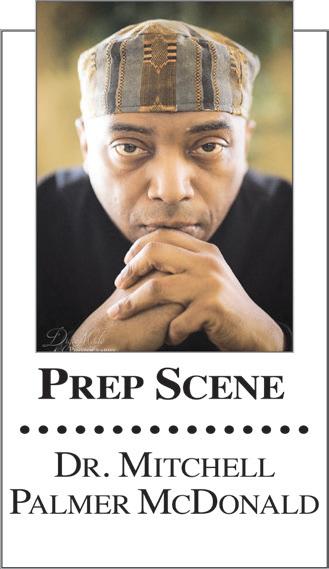
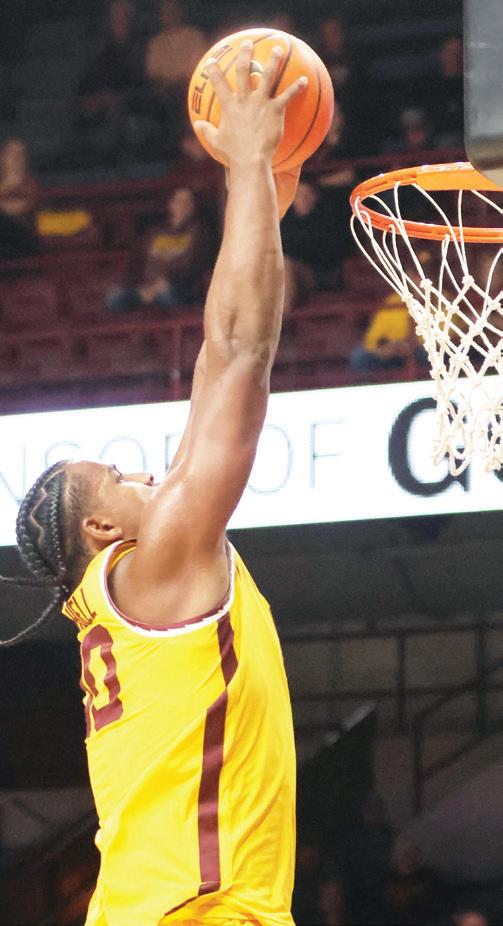

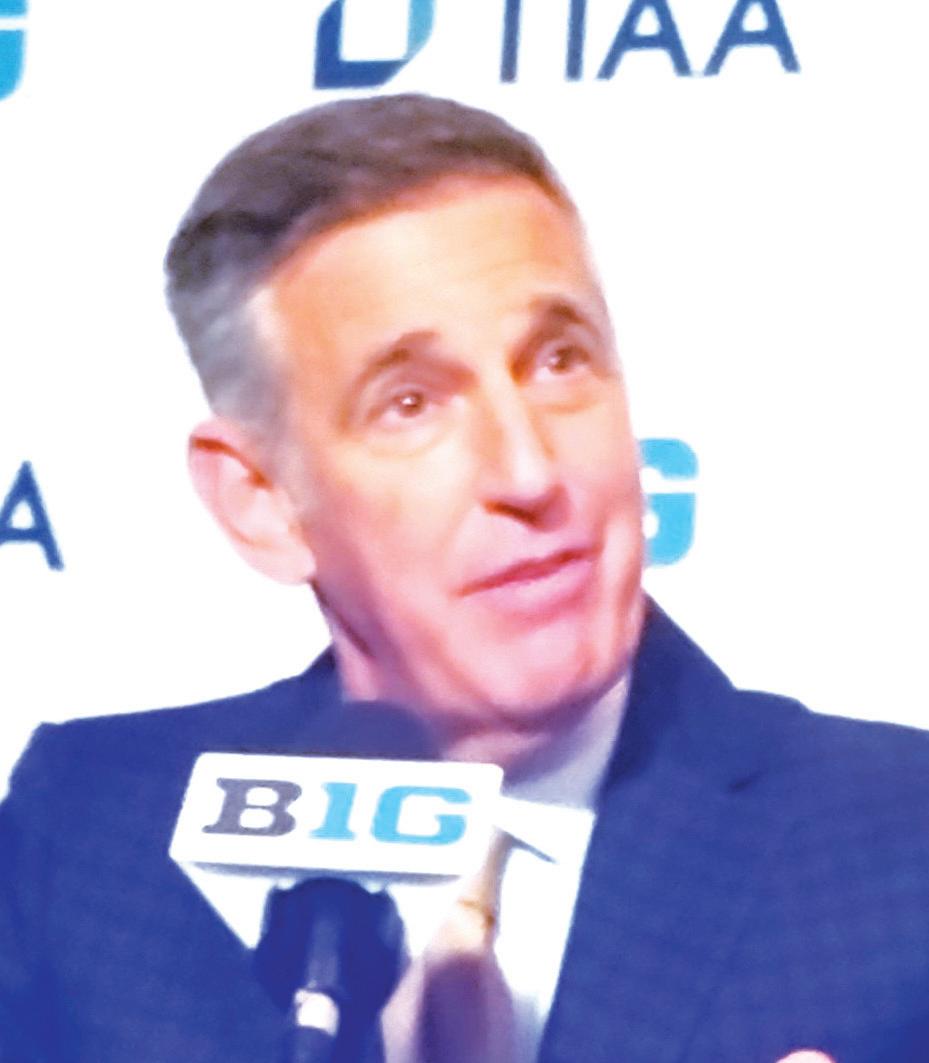
“Women coaches of color are dramatically and disproportionately underrepresented, given fewer opportunities,
“We don’t often get the great job. We don’t often get that opportunity.”
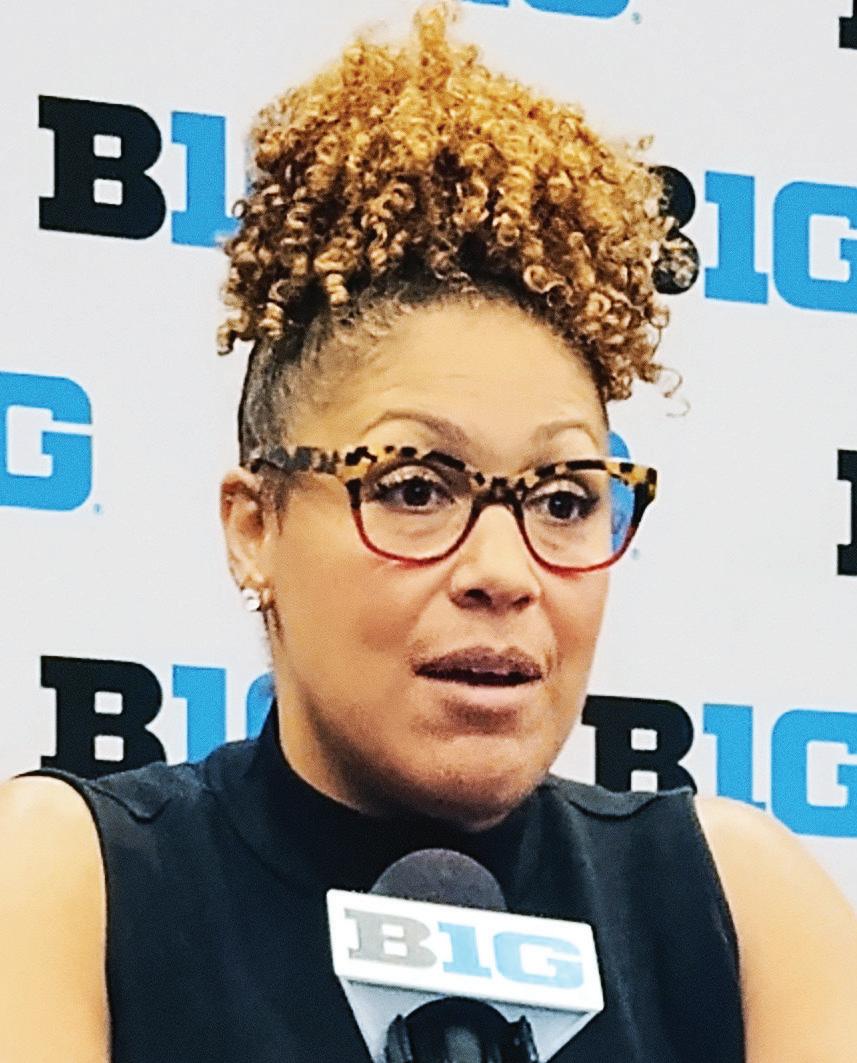
and face additional barriers due to the intersection of sexism and racism,” its executive summary points out.
White coaches held the majority (2,994) of Division I head coaching positions (81.1%).
The number of head women coaches of color in 2021-22 (245, 6.7%) of women’s teams increased to 308 (8.3%) in this year’s report, the highest recorded in the four years of
gathering racial data, says the WCCRC.
Squash and wrestling (50%), track and field (43.5%), basketball (36.5%) and soccer (12.4%) rank at the top among 28 sports, while other sports had zero women head coaches of color.
Coaching diversity remains a rarely discussed topic in PWMs (primarily White media), but
■ See VIEW on page 13

“There’s of course some room for growth as there always is within the game or anything you want to pursue in life.”
here are approximately 100 African American and other student-athletes of color this school year at the University of Minnesota. In an occasional series throughout the school year and sports year, the MSR will highlight many of these players. This week: Minnesota sophomore middle blocker Calissa Minatee.
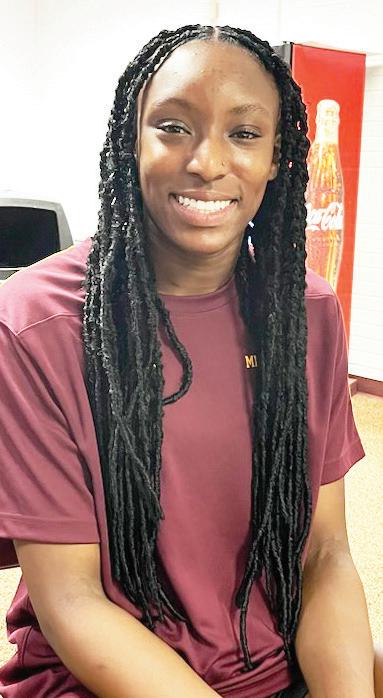
his week’s Fab Five photos feature participants in the University of Minnesota’s 90-65 exhibition victory over Bemidji State University at Williams Arena last Saturday afternoon.
Senior guard Mike Mitchell led the winners with 19 points and eight assists. Senior for-
ward Dawson Garcia, a Prior Lake High School standout, finished with 15 points. Former Cherry High School star Isaac Asuma, a freshman guard, contributed eight points and eight assists, while junior forward Frank Mitchell’s physical play led to the forward adding six points and seven rebounds.
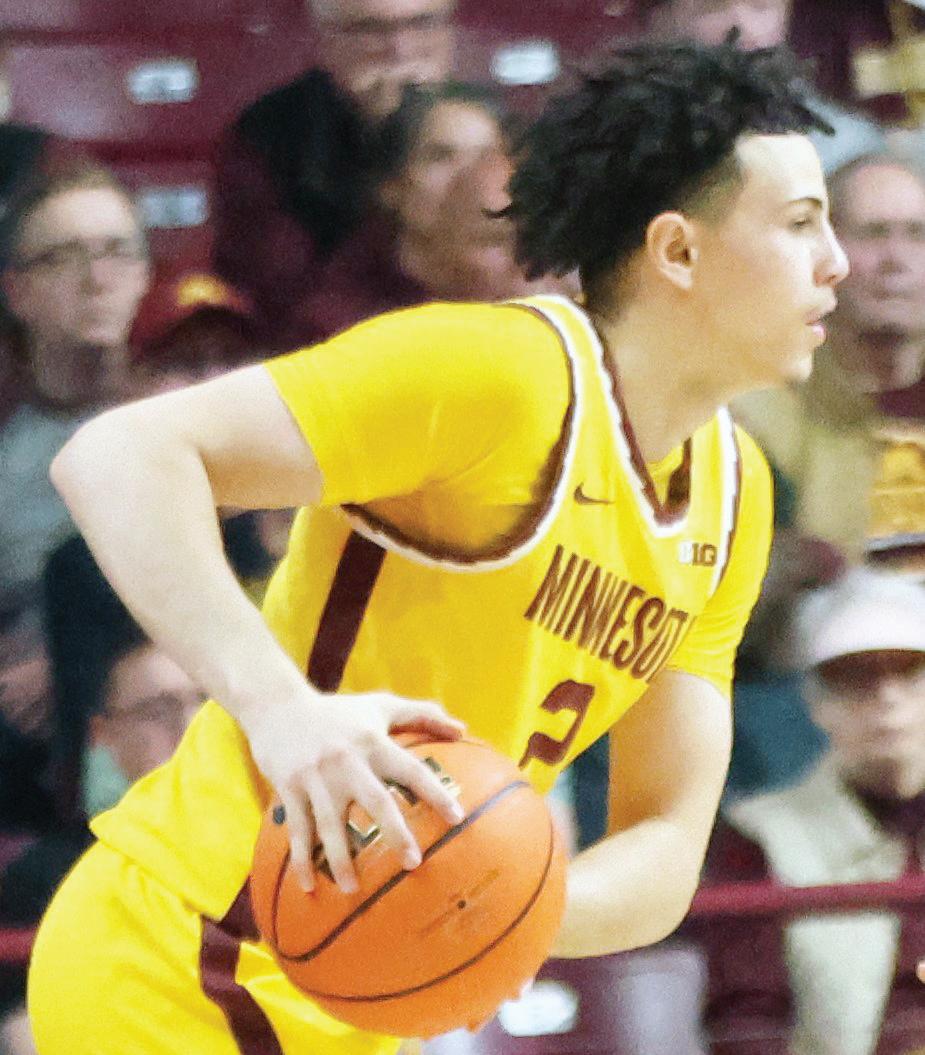
Calissa Minatee this season is more in the middle than a year ago. The 6’1” sophomore from Kansas City, Missouri is a starter for the Minnesota Golden Gophers volleyball team this fall.
“Yeah, I think I definitely understand what my role is on this team a little bit better or a lot better this year,” said Minatee earlier this season. Her freshman season was Minnesota Coach Keenan Cook’s first as well.
Minatee twice this season posted a career-best 11 kills (against Wisconsin September
■ See SOE on page 13
Dr. Mitchell Palmer McDonald welcomes reader comments to mcdeezy05@gmail.com.
All photos by Dr. Mitchell Palmer McDonald.
Though Bemidji State suffered a setback, the day was special for Peyton Newbern. The 6’4” junior guard from Robbinsdale Armstrong was playing on the same floor where his father, guard Melvin Newbern (1986-90), starred. The younger Newbern finished with eight points as his father and college teammates Willie Burton and Connell Lewis looked on.
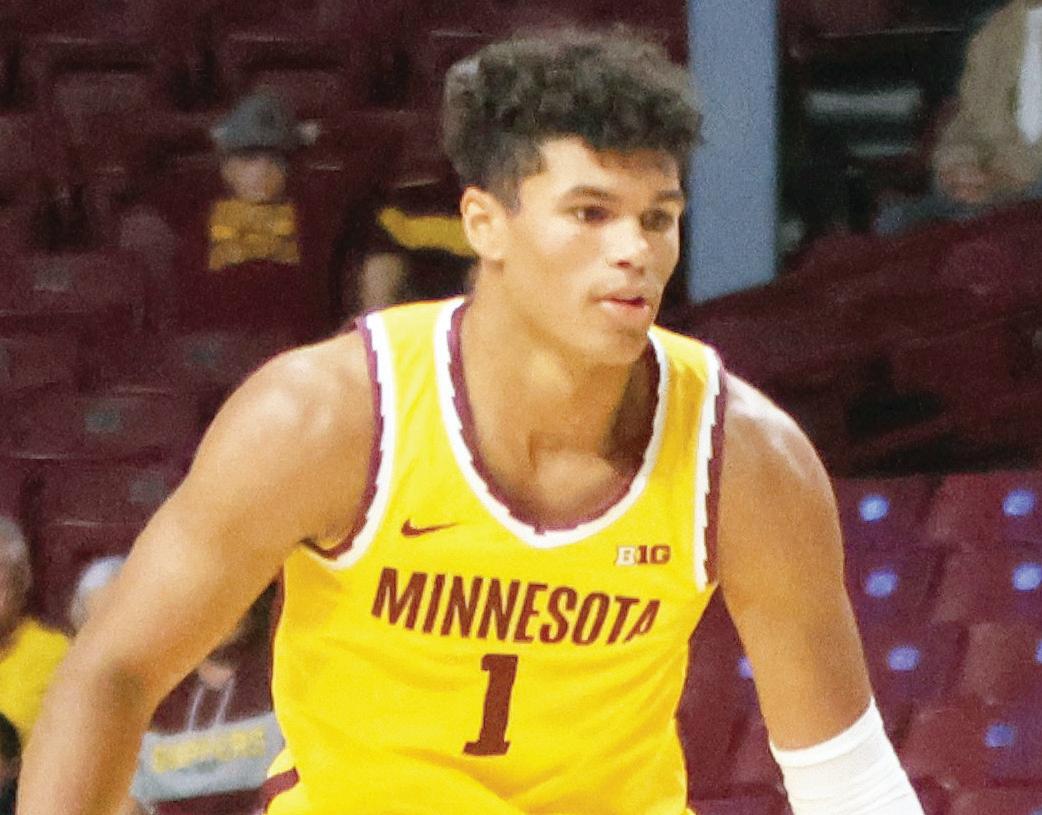
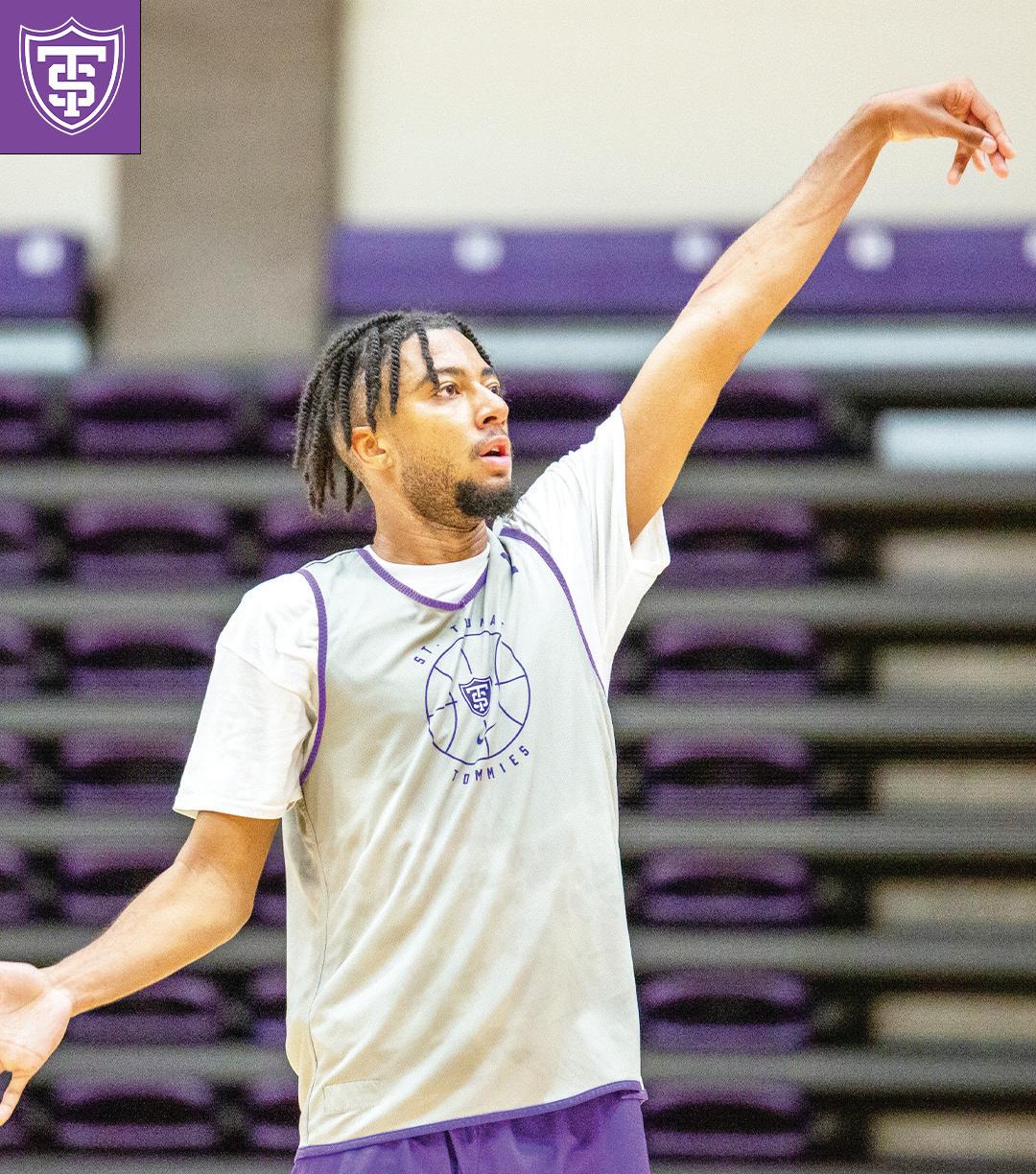
By Charles Hallman Sports Columnist
unior

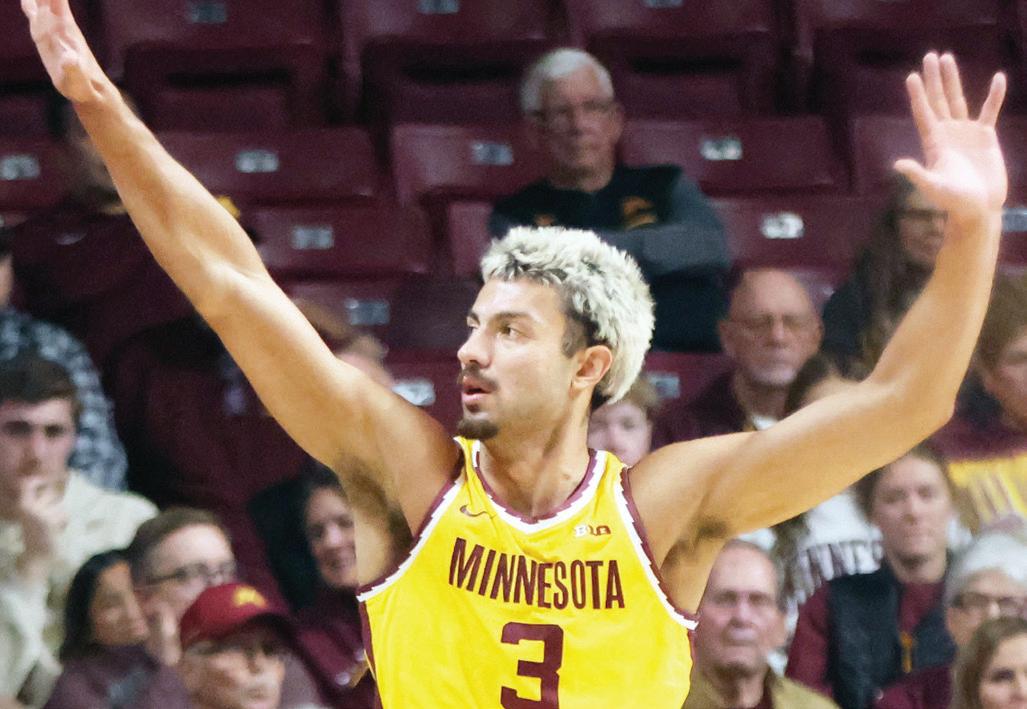
By Charles Hallman Sports Columnis
